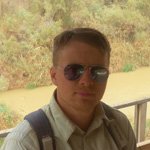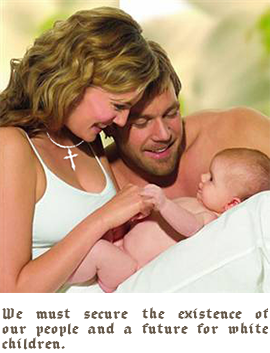Expedition to Lebanon 2015
All travel reports are translated electronically although minor improvements are sometimes made.
Expedition to Lebanon 2015
My trip: Beirut, Jeita Grotto, Jounieh, Harissa, Byblos, Tire, Sidon, Chouf Mountains (Beiteddine, Moussa Castle, Deir al-Qamar, Barouk, Cedar Trees Reserve), Jezzine, Mleeta, Tripoli (Al-Mina), Dolina Qadisha – (Bcharre and around), Bekaa Valley – (Baalbek, Anjar, Zalhe).
An incentive to travel around Lebanon
Before I went to Lebanon, I heard a lot about that small and a very interesting country and that’s why I wanted to explore it my own way. From the stories of other travelers it is clear that Lebanon is a very attractive and also safe country, although the media controlled by evil Jews make it clear to us that a trip to Lebanon threatens health and life. The British Ministry of Foreign Affairs has even drawn a comic map of Lebanon where the northern and eastern areas are red, and which I understood that they shoot over there without warning. Out of curiosity, I visited all the “red areas” highlighted by the British Ministry of Foreign Affairs, and it was so nice that I stayed for 16 days.
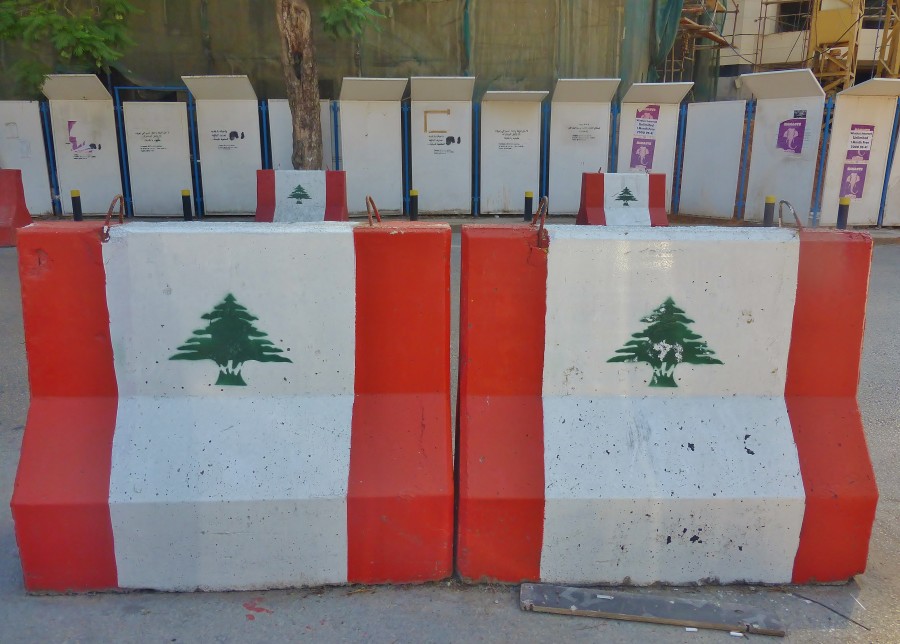
Lebanon; concrete blocks on the road in Beirut.
During my trip I swam in the Mediterranean Sea, I saw beautiful Roman ruins, picturesque valleys and beautiful churches, I had Arabian sweets, I was in old Arab cities and twice I was interrogated and checked by Hezbollah. There were a lot of weapons in Lebanon at every turn, a lot of yellowies, concrete road blocks, armored cars, big cannons, kilometers of barbed wire and military bases on beaches and under bridges, both in Beirut and in other cities. Although, I think that Lebanon is a safe country for tourists and the Lebanese are not hostile. I was arrested and interrogated by Hezbollah, and in some cities, especially in close proximity to Israel, someone told me to delete some strategic photos, but this should be treated as a formality and not as a real threat.
The European media and the British Ministry of Foreign Affairs are in my opinion next year’s Oscar winners for horror that never happened. I therefore urge all travelers not to trust our media and go to Lebanon, especially since this country also has beautiful nature and our wonderful Christian history and culture.
I write my report in such a way that it is a tourist guide that every traveler will be able to print and take with him to Lebanon.
Beirut
Initial description of the capital of Lebanon
At the airport in Beirut, the briefing went quite smoothly, although it was clear that they did not like Israel there. Before the soldier gave me a free passport visa, he asked me twice in a raised voice whether I was in Israel. I landed at 2 am, so I could not go to the hotel at this time. So I turned a little around the airport, I tried to sleep, but in the end it turned out to be impossible and boring, which is why I decided to get to the center. The taxi drivers wanted $ 25 from me, which is why I left the airport alone for the main road and stopped a private car that would take me to the hotel for 7,000 Lebanese lires. I got out at night, in a dark empty street, working on the imagination. When I knocked on the door at 4.20 am, the head of the hostel was pissed off and asked if he deserved to sleep. But then he let me lie down on the sofa on the second floor. When the new day arrived and the boss was in a good mood and I took a shower, paid and went to the room. It was the cheapest possible, Talal hostel, for $ 16 a night, which was 500m from the center, 10 minutes by taxi from the airport and about a 10 minute walk from the Gemmayzeh district.
I lived by the Charles Helou bus station, in the city center, which served several directions in Lebanon, though not all. Charles Helou station was under the bridge, it was dirty and gray-bury but in 4h I got Tripoli.I got to many other directions from further stations, such as Cola and Dora. In general, the principle must be taken that the Charles Helou station serves directions north of Beirut and the Cola station serves the directions south of Beirut.
After a few days of moving around Beirut I came to the conclusion that the best are taxis, and if I was traveling by small buses, it was only after dark, because in the day, in traffic and on the principle that everyone could get in and get off when he wanted, it was faster to go than drive. In addition, there are two types of taxis in Beirut: the first is divided taxis of 1000 lire per passenger, but then we do not always get exactly to the destination; and the second type is a service taxi, which is our private taxi that takes us where we want. I advise you to look out for a taxi in Beirut painted on the flag of Lebanon, also from the inside. It’s a big attraction and I was lucky enough to be driving – for 4000 lire.
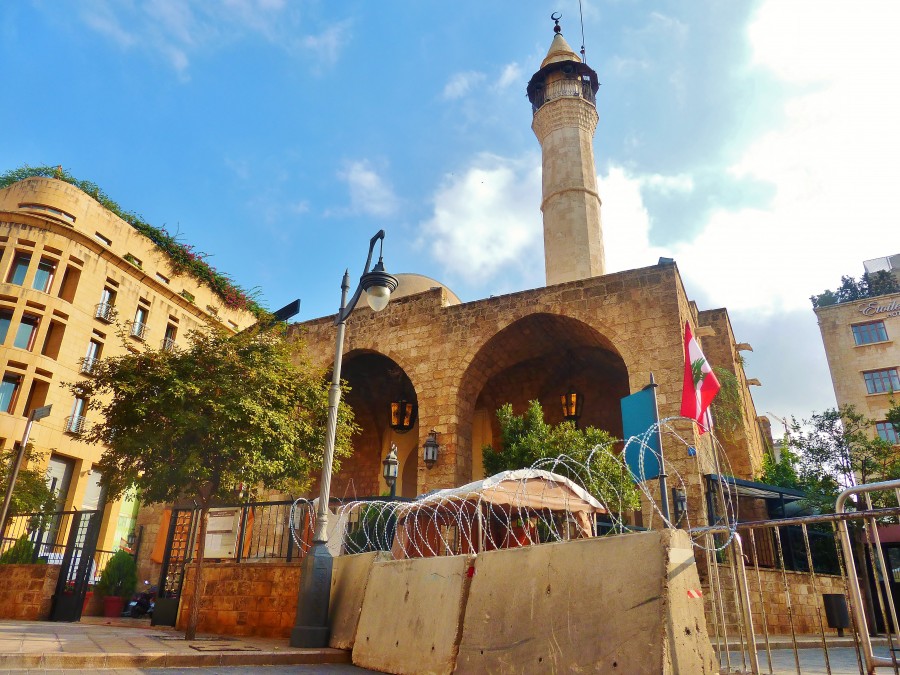
Lebanon – barb wire and conrete blocks were a common site during my trip around Lebanon.
For the first few days I wanted to visit Beirut, but it is important to say that you should travel in Lebanon differently than in other countries. Well, Lebanon is a very small country, which is why Beirut has been my base for many days, from which I organized trips to other places in the country. If someone has only one week in Lebanon, I advise you to rent a hotel in Beirut and organize trips only every day because this way you can see many places. From the perspective of the tourist Beirut should be divided into several districts, although in my opinion, not all are interesting. In some districts there are monuments and in others there are only shops and shopping centers, also Beirut should not be judged only on the basis of monuments and competitive places of interest but through the primacy of the whole city, which is very interesting.
Districts in Beirut are: Center (called Downtown ), Achrafieh , Hamra , Gemmayze and very pleasant Corniche . In addition, there are many interesting facilities, such as museums, mosques, churches and universities. In my reportage I will write about the most important places not to rewrite the guides, and also to present my own vision of Beirut.
For me personally were also attractive Muslim pubs where late Arabs baked Lebanese pizza, I also liked teahouses in dark streets, coffee in the morning in very non-tourist places and the military aspect of Beirut . Unfortunately, in 2015, I could not go anywhere, because some of the objects were fenced with concrete barbed wire and barbed wire, and soldiers armed with machine guns did not always look happy when I took pictures of certain objects. I saw that even when the military police did not say anything, the soldiers watched me like television, suggesting that they do not trust visitors in Lebanon. Under some bridges, I also saw armored cars and rocket launchers, probably in the case of Israeli fighters. In addition, you could feel the nervous atmosphere and it is not only about the city turned into a war zone, but also because of the slogans on concrete entanglements. I read on them, among other things: “He can love his country, at the same time not loving his government”, but there were pictures of killed partisans next to them. This is how I visited Beirut.
Beirut – Downtown
When I left the hostel, first on the street, I saw a few soldiers lurking with machine guns in concrete booths, and then I saw a huge advertisement depicting Lebanese politician. Soon, however, I reached a huge mosque, which size dominated this part of the city. It was the mosque of Muhammad Al-Amine , built in 2005, also called the “blue mosque” because of the blue dome, although in my opinion Lebanese want to have a mosque as the Blue Mosque in Istanbul, and hence the name. Inside, you can admire Muslim calligraphers on a yellow, orange, sometimes blue background, made by the masters of patience. It is an object that is definitely worth seeing, and even if someone does not want to see it, he will surely see it, because his minareas alone are 65 meters high, and even when dark night falls, it is also visible because it is backlit. The Al-Amine Mosque was funded by former Prime Minister of Lebanon Rafiq Hariri.
Just behind the mosque is also the mausoleum of the former Prime Minister of Lebanon, which, ironically, was blown up in 2005 on Valentine’s Day. I suppose that’s how the feast of lovers in Islam looks like. In front of the Al-Amine Mosque, the Martyrs’ Square is not to be missed, with a monument of three people commemorating the Lebanese nationalists murdered by the Ottomans in 1915-1916. Today, however, this square is used by the media as a center of political fights and brutal revolutions and is constantly changing.When I was in Beirut in 2015, Martyrs Square was run down, full of debris and rubbish, but I think that the next time I go there, it will be a beautiful park with palm trees and a fountain and a route around Piccadilly Circus. I would do it.
Let’s also hope that in a few years archaeologists will dig out the Roman Baths from the rubble, and that they will be open to tourists. I urge travelers to ask if they are open.
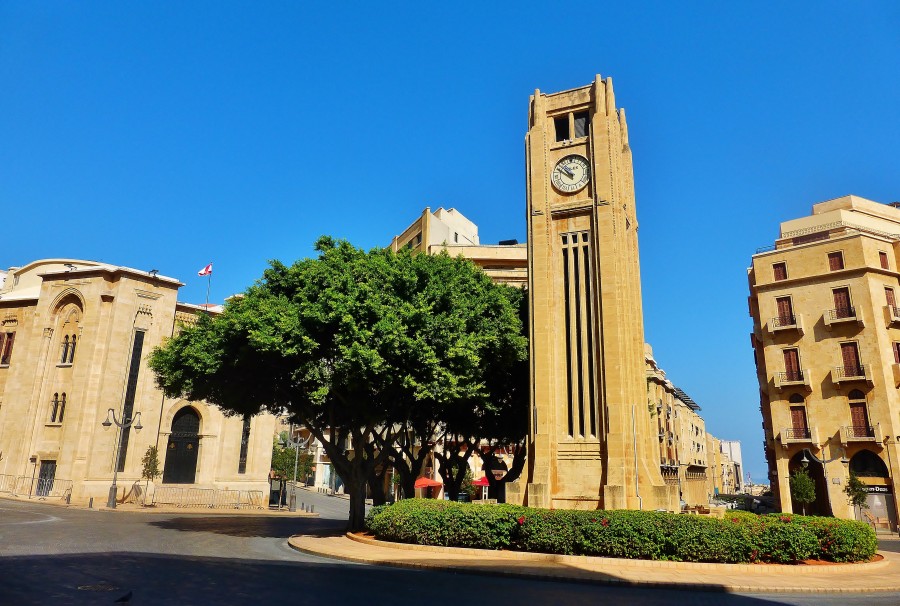
The Parliament of Lebanon and the Clock Tower.
In Beirut, it is impossible not to notice two rival religions: Islam and Christianity. Alongside the Al-Amine mosque stands the 19th century St. Jerzy Maronita . His tower, with a large backlit cross, is 72 meters high, and the whole cathedral has recently undergone a major renovation. Both the church and the mosque are characteristic features of the Beirut city center, which is still being rebuilt after the civil war and are located near the front line that divided Christian East Beirut from the Muslim western Beirut during the conflict. Traveling around Lebanon many times have convinced myself that for political reasons, religion and religious identity are extremely important.
Then I went to Nemjeh Place , where there were, inter alia, the Parliament of Lebanon and the Clock Tower , built by the Ottomans in 1897. In addition, there is a good restaurant area and attractive streets, although the whole was unfortunately fenced with barbed wire and armed army. A few days earlier, apparently, you could not even go there, but when I was there, tourists had free admission, but due to the bombings, not locals. Noteworthy is also the Greek church of St. George , completed in 1772. Right next to Nemjeh Place stands the Grand Serail building, which is the official headquarters of the Prime Minister of Lebanon. Unfortunately, moving even at a short distance from this object was impossible because it was separated by barbed wire and concrete entanglements and armed forces. It is a pity, because it is a very attractive building, but well, it is already in Lebanon.
In addition, in the Downtown district there are bazaars, dark streets with broken buildings that have not been rebuilt after the civil war, there is also a cinema in a modern building and a huge bazaar – Beirut Souks . However, this is not a traditional Muslim bazaar that I have seen in Istanbul, in Tehran or in Kashan.In Beirut it is a commercial for huge money, with the stores of the most expensive companies. Instead of Arabic spices and sweets and instead of rugs, there are jewelry, perfume handbags and costumes of the most expensive western companies, and those who have money can dress their women in short skirts and high shoes and go to a party on a high floor in the center of Beirut. It is in vain to look for tradition here and it is definitely not an area for budget travelers. The insightful are able to reach many other places and places of interest in this district.
Beirut – Gemmayze
Gemmayze is basically one long street called Gouraud, located near Martyrs’ Square. It is part of Beirut where there are many pubs, restaurants and nightlife, but this is soon being replaced by Downtown, which has many more attractions. In my opinion, the way to get to Gemmayze is important, and I think it should be done only by the stairs of St. Nicholas . These stairs are long, painted in many colors and decorated in grafiti, although along the way you can also admire the laundry hanging out by the inhabitants and numerous plants in pots. Twice a year on 125 steps, festivals and art exhibitions take place. Besides, in my opinion, in Gemmayze you can eat and go to the pub, but that’s all.
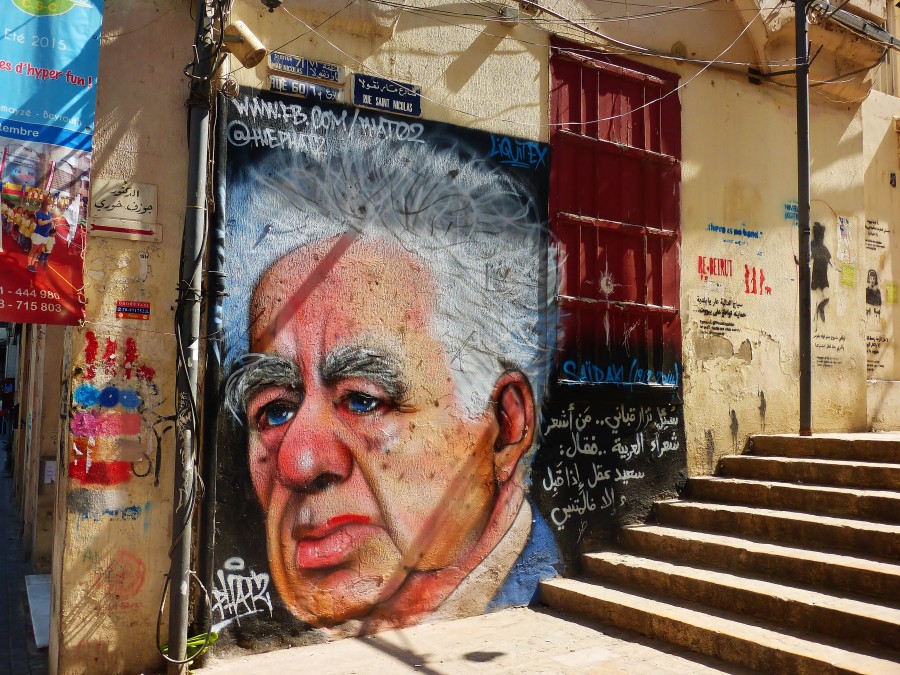
Street art. Lebanon, Beirut.
Beirut – Achrafieh
Achrafieh is a larger district because it starts from Damascus in the west, then to the east bank Beirut, and in the south to the National Museum. In Achrafieh, near the stairs of Saint Nicholasa, there is a very nice white building with winding stairs and sculptures in the garden. This probably the most beautiful building in the whole Beirut is the Sursock Museum, which is a local money monument built in 1912, and which was closed when I was there. Unfortunately, but I could admire this object only from outside.
I also recommend the Greek Church of Saint. Nicholas, who is at the top of the 125 steps of St. Nicholas, with a red dome at the top. I spent most of my time in the gardens of St. Nicholas on the other side, where there are statues of Greek gods and a neglected blue pool. There is a nice break from sightseeing with a view of the church, although I was not fascinated by this garden. Before I walked in, first I had to show the contents of the backpack, if I was a terrorist. That day my time was already over, so I wanted to see but one more important object.
It is true that the Lebanese Museum of Prehistory was nearby, but I preferred to take a taxi and go to the National Museum of Lebanon . For only 5,000 lire, I’ve leased two floors of Lebanese history under one roof. The museum has collections in about 100,000 objects, most of which are monuments and medieval finds from excavations conducted by the Directorate General of Antiquities. The Museum in Beirut displays around 1,300 artefacts, from prehistoric times to the medieval Mamluk period. On the ground floor were huge sculptures, sarcophagi and mosaics depicting Greeks and Romans. One of the sarcophagi presents Achilles and the most valuable mosaic presents 7 wise men, including Socrates. The Lebanon Museum in Beirut has artifacts from the Bronze Age, through the Greek, Roman, Byzantine and Arab conquests, and many of the items that are found here include the Roman ruins of Baalbeck and Byblos. It may sound unbelievable but despite the weight of history, the perfectly round butt of one visitor remained in my memory.
Because of the civil war, this music was forced to cease activity in 1975, and then began long and very expensive restoration work, thanks to which it was reopened in 1979.
I went to the pub on the way and then went back to Downtown, by bus, from where I went to the hostel.
Beirut – Hamra
The next day I went to the Hamra district, where there is absolutely nothing to explore. Hamra is a district of mid-range hotels, restaurants and shops of all kinds, and Hamra Street’s main street is always full of buyers, passers-by and restaurant customers. At exhibitions of this mostly Muslim country you can, for example, see scant lingerie for women, while I came here sometimes in the evening to come along side streets requiring renovation, to photograph the best wrecks that still rode, and I also used the Internet. In other words, most people come to Hamra to get drunk, eat and shop.
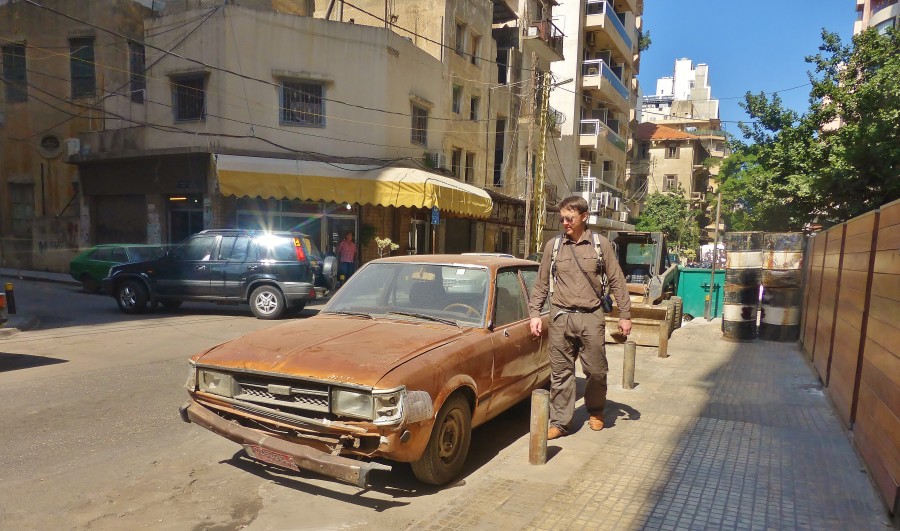
In the Hamra district with a stylish car. Lebanon; Beirut.
There are two places in the Hamra area that I can recommend. The first is the Sanayeh Garden , with a large round fountain, a nicely trimmed lawn and giving trees a blessed shade. Here I rested from the heat, drank tea and ate the corn in peace. I recommend this place to all travelers. Almost next to the gardens is the real star of this district, the American University of Beirut . It is a huge object built in the European style, with its own tennis court and many buildings and green areas, which was opened in 1866 and is a prestigious higher education institution in Lebanon. This university teaches all subjects in English. The American University of Beirut is located on 61 acres, has 74 buildings and even its own beach. In addition, the university is located on the mountain, is covered in greenery and has a beautiful view of the Mediterranean.
I recommend travellers to come after this place for about an hour or two because the very presence there is very relaxing, and for me it was interesting to say that I had conversations with students. I talked longest with a young Muslim woman in a short skirt, who was very interested in me, but immediately escaped when young men appeared. Then, going down to the coast, I was approached by many students who were very tiring because they asked me a lot of questions. I left the university on the other side and this way I found myself in Corniche.
Beirut – Corniche
Corniche is my favorite place in Beirut. It is an 8km promenade on the Mediterranean, which is a great place to relax at any time of the day or evening. Along the Corniche are planted palm trees and the promenade itself is always full of runners, skaters, sellers of corn, ice cream and Lebanese bread with sesame seeds (ka’ik). There are also women running in tight dresses and those wrapped in black sheets. I used to walk around the Corniche many times, until the last day of my stay in Beirut, and then when I was still there. I also liked the place where men swam and jumped from the rocks. I also jumped and swam with them, which was not only fun but also a relief in the hot climate of Lebanon. In addition, whole families meet on the Corniche for picnics, anglers and Polish tourists, like me. Also from a social point of view it is a great place.
However, there are a few places in the Corniche that I would like to mention, although I still think that the 8km promenade with palm trees and the place to swim are the best. Near the Riviera Hotel there is the Manara lighthouse , which Israeli army spared, because the Jews only wanted only to “turn off” the light. Next is the Beirut Luna Park theme park , which is popular with families with children. I admit that it’s nice to spend time on all merry-go-rounds, but it did not impress me. The best of the entire park were cars that could be broken up. Still, I still preferred to jump into the sea from the rocks.
At the very end of the Corniche, however, there is a huge geological attraction; 60 meters high Pigeon rocks, which are a reminder of the earthquake. Today it is a very romantic place, with restaurants overlooking the rock. To see the rocks from sea level, you can walk 100m down a well-trodden road and then pay $ 20 for a boat trip around the rocks. It is a pity that I was there only once because it was an exceptionally beautiful place.
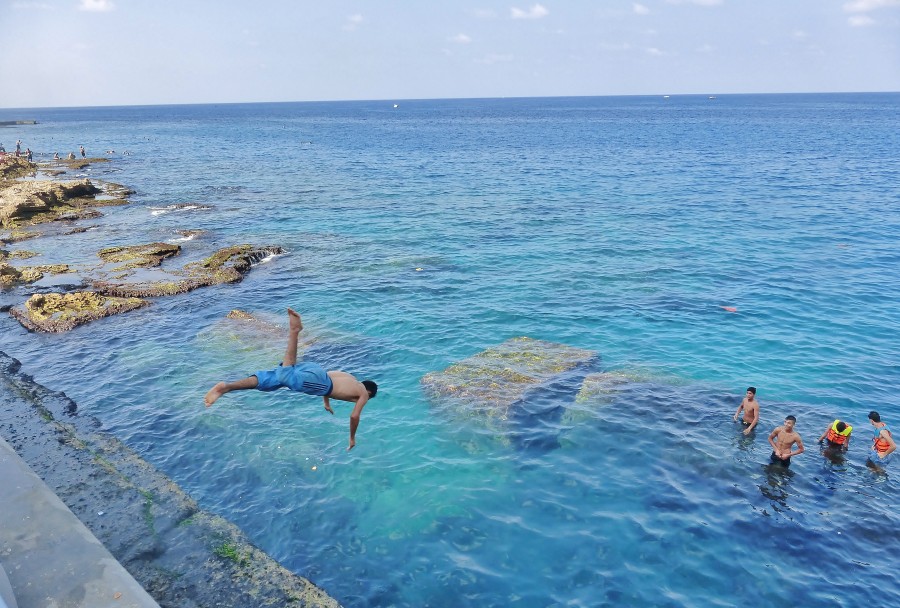
Lebanon; Beirut – a flying Arab in the Corniche district.
Other interesting things that happened to me in Beirut
Being in Beirut I had some interesting adventures and observed some interesting things. Each traveler has his own private observations, which should be shared to get to know the country and the travelers encountered on the road.
When I was in Beirut, the Lebanese once again organized an anti-government fight, this time near Martyrs’ Square. They threw stones and firecrackers at the police, while waving Lebanese flags. The police, however, were very patient and tolerated this argument for a long time. Armored cars stood quietly and took stones, but after a while the policemen felt so tired that they first fired the gas and then went in with their clubs and began to play out company. It was a good action, and I know it well because I was in this crowd, I heard their war cries and saw them throwing stones. Fortunately, nobody moved, which means that Lebanon is a safe country for tourists. The police, however, then surrounded me and asked me questions but quickly let me go. Maybe because I was with a German friend who looked very peaceful.
Once I was on a political demonstration, but in Daka, in Bangladesh, and nobody moved me either, because they saw White with a camera, so they decided that it was not my business. After all, I went to the Arab street to a dark street, where dusty, sweaty Arabs baked local delicacies and smiled at me like they were stupid to cheese.
As for the German woman, who I met several times, unfortunately she turned out to be more stupid than I could imagine. She just returned from her one-year stay in Pakistan where she taught German, and she was so stuffed with Muslim culture that she once said: “May Allah give peace to Lebanon”, and I thought: “how Germany can survive, if their women are calling Allah for help.” Tragedy. The German woman was already a few years old, she just broke up with her German boyfriend and said she did not plan to have children. Well, I said that the Arabs and Turks in Germany have two and even three wives and they will have such a huge birthrate, that soon they will remove Germans from Germany. She did’t give me any answer. Then, we were joined by a German man, with whom I later went on a trip, that’s why I told the stupid German woman that now he had the opportunity to save Germany and let the German man to make her pregnant, and if not by him, then at least she could help save the White species and do it with me. She however, smoked her shisha and turned red of shame. Unfortunately that was not the end, because the German man had a woman from Romania and planned a family with her. Well, Ican see poor survival chances for Germans, but the English are the same.
When I returned to the hostel one evening, it turned out that the rep, probably revenge because I woke him up at night, he put a Negro in my room. It is a pity that I did not see my own reaction but before I opened the room I still had a good mood. Suddenly I look, a black man! Immediately I ran to the reception and told the boss to get me a black from the room, to which he replied that he knows that his feet stink but he did not have it where to put. I replied that the stench of his feet did not bother me because I was smelling myself like an old goat. The problem is that I do not like the Negroes. The receptionist replied that he has a room without blacks on another floor but it will cost me $ 2 more per night. Of course, I agreed.
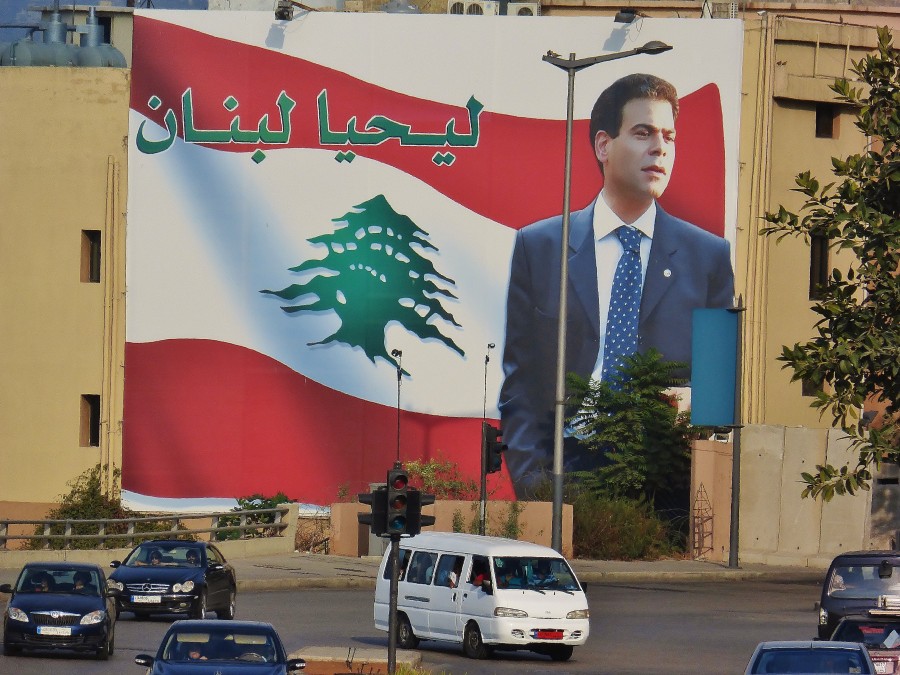
Lebanon; Beirut.
After changing the room it was fun. This time I shared a room with a boy from Chile and a Jordanian Arab who came to Lebanon to marry another woman. The Arab from Jordan was able to tell interesting stories and he was able to squeeze the putty so that it inspired. First, he tried to convince me of the superiority of Islam over Christianity, but he quickly gave up because he had two Catholics in the room and decided to change the story. He talked about the fact that he has a pretty wife in Amman and a little son, and he came to Lebanon to marry a young girl from Syria. He said that if he could, he would have a third wife, but he is currently working on a second wife. The Jordanian boasted that he had a good life, because he had a good job and his apartment, and his first wife also had her own apartment and also has a job, which means that the conditions for marrying a second woman are ideal. A young girl from Syria, whom I met later, was very pretty for an Arab woman, and my Jordanian drooled from his mouth at the sight of her.
Unfortunately, we felt a bit sorry that he had already spent $ 5000 for her and her parents’ arrival in Lebanon, and for their entire maintenance, and that was not the end of the costs, as he had to take them to Jordan for a wedding and a wedding reception. I asked him if his first wife agreed, to which he replied that she did not, but she did not have to agree, because in Islam women had nothing to say. In fact, it was a great pleasure getting to know him. But to sum it up, this was how Arabs with brown asses had fun, and he wanted more.
Then I shared a room with a Syrian immigrant who was a doctor and also a very decent person. We had many serious discussions together, including about my political views, and oddly enough, he said he agreed with me. In Europe I would be hailed as a Nazi, but I told him exactly what I thought and said that the Jews destroy Arab countries through wars and they destroy Europe through mass non-white immigration, race mixing and the promotion of perversions. The Syrian doctor said he agreed with me, but also that he was surprised to hear it from me, because when he spoke to other Europeans or Americans, they were guilty of little children, because they all believed Jewish lies. He also said that as long as the Jews rule Europe and America, the world would never be safe. We drank tea and talked together, also about his work in Saudi Arabia. He said that when he worked in a hospital in Saudi Arabia, women accosted him. Especially those with covered faces wanted him the most, and according to him, the ones that are the most covered, then are the best in a relationship and treat a man best.
Travel enriches, not only because of the sights that I see, but also because of the people I meet. I realize that my political enemies only want to see me in an SS uniform, but that’s not true. I don’t want wars, I don’t want colonialism and exploitation. I just want an ethno-cultural balance.
Being in Beirut, I visited the same places many times. I’ve been to Hamra for meals and on the internet and jumped from rocks into the sea at Corniche. I also often wandered around non-touristic neighborhoods, which turned out to be very interesting. I’ve seen dilapidated houses and walls with bullet holes. However, I think that if Lebanon will not be provoked by Israel and Hezbollah and Christians will shake hands for the good of the country, then Lebanon can be a very pleasant country for tourists because it has great conditions for it.
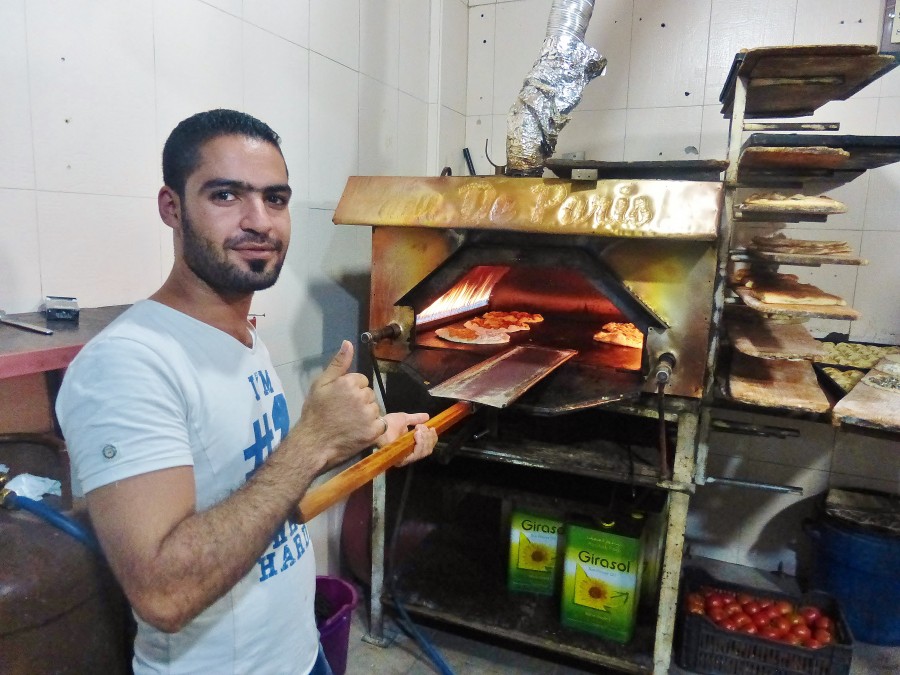
Lebabnon; this Arab made me a good bread.
For those who are interested, I recommend a trip to Yara to see a great monument called “Hope for Peace” , which was built to commemorate the civil war in Lebanon in 1975-1990. This monument consists of tanks and combat vehicles stacked one above the other. I did not go there to see him especially but I saw him standing on the road in traffic
A one-day trip to Jeita Grotto, Jounieh and Harissa
After morning tea and peaceful farewells of Arabs in my room, I went to the Charles Helou station, from where I took a bus going to Tripoli. However, I got off much earlier and the driver was nice enough to drop me off the road at the Jeita cave. Besides, there is a sign on the road that you have to turn right and besides, there is a bridge in this place. I drove 2,000 lire for access to the bridge, then hitchhiked a bit and paid another 2,000 lire for a taxi service to enter the caves.
Jeita Caves is one of Lebanon’s greatest attractions outside of Beirut. There are wonderful water caves and geological richness in the form of rock formations, limestone walls, stalactites and stalagmites. Jeita Groto is a system of two separate but connected caves with a total length of about 9km. The biggest point of the program is there is a boat trip inside the cave with turquoise water, and with the skillful use of lights.As long as tourists can behave, it is a beautiful and peaceful experience that also gives a pleasant chill.Outside, there are beautiful mountain views, the Pies river and the cable car. In addition, there are also souvenir shops and interesting sculptures that reminded me of Poseidon, although someone may have different associations. Unfortunately, inside the caves, you can not categorically take pictures, but I did it anyway.
Jeita Groto is located about 20km from Beirut and is such a popular place that every year is visited by over 250,000 tourists. I paid 18,000 lire for the ticket. With Jeita Groto I went to the main road on Tripoli (which is where I came from) and then I stopped the bus and for only 1,000 lire went another 2km to Jounieh.
Jounieh is a small coastal town with mountain views, and the Lebanese capital of nightlife. When I entered Jounieh, this little thing, basically consisting of one long street, did not look bad. First I saw a football field and then sat in a bar for a good Arabic meal. Soon, however, I saw Amsterdam Super Night Club, which was a bar with a strip and so-called “massage salon”. Walking along the street I saw many such bars, which explains why Jounieh is so popular among Saudi tourists. Shortly after the ceasefire in 1975, Christians began coming down to Jounieh, and the city quickly became the center of entertainment. There is a lot of luxury hotels, restaurants, brothels and Casino Du Liban, where rich Saudas play until the morning.
At the end of the main street in Jounieh there is a cable car “telefrique”, which for only 5,500 lire one way, I drove to the mountain reading, to the church in Harissa . Harissa consists of two villages located at 550 m above sea level, around 27 km of Beirut. From the top of the mountain there are nice views of Jounieh and the Mediterranean Sea, if there is no fog, but Harissa is on the tourist map because of Our Lady of Lebanon , which is one of the most important temples to honor Virgin Mary and is certainly the most important Christian center in Lebanon, from 1904, when it was built. On the chapel, where the foot goes up to the top, there is a huge 15-ton statue of the Mother of God, which is 8.5m high and 5m in diameter. Our Lady of Lebanon in Harissa has her hands extended towards Beirut and attracts millions of faithful Christians from all over the world. Pope John Paul II visited the Mother of God of Lebanon in 1997, and his goodness, the real angel Martin Malik was there in 2015. I liked the whole monument, and of course I would recommend it not only Christians but also to Jews and Muslims, so they could become better.
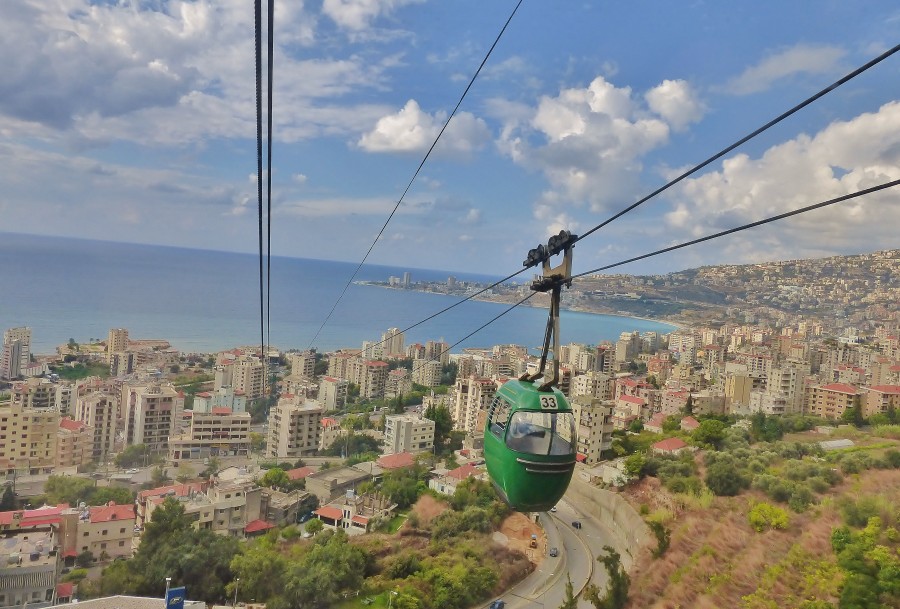
View from the Harissa summit, where Our Lady of Lebanon is located, to Jounieh and the Mediterranean Sea.
My return trip from Harissa was also nice. First, I went down the main road on foot and got busted at the St.Paweł, and then I hitchhiked to Jounieh. Then, once again, I invited myself to a small snack in a Lebanese pub, and then from the main road for only 2000 lirs I returned to Beirut, to the Charles Helou station.
That same evening in Beirut I was not bored a bit. First, I rode a Lebanese taxi that bumped into corners, then I was on the street, and at the end I went with a German friend to an Arab pizza. I heartily recommend all the places I have discussed in this chapter.
One day trip to Byblos
The next day I went to Byblos, also from Charles Helou station, as it is a direction north of Beirut. At the station, however, I met a very nice Russian woman who turned my head over there that I went with her all the way to Tripoli. Then I had to head south back to Byblos, but it didn’t take long. The distances in Lebanon are very small and I have often only moved along the coast. It is only less than 40km from Beirut to Byblos, which takes 30 minutes. You can also get to Byblos from the Cola station, which parks in the center of the town, but I preferred to take the bus to Tripoli and get off on the way.
Byblos (Jbail in Arabic) is one of the prettiest small towns in Lebanon, with a lovely harbor, fish restaurants and lovely sunsets. There is also a nice souvenir market in Byblos, which in my opinion is much better than the one in Beirut as it is more traditional and easier to navigate. Byblos has been inhabited continuously for at least 7,000 years, and various civilizations have left their traces here, which, apart from the charm of the city itself, should also be enough reason to spend at least one day here. These were, in turn, the Phoenician, Greek, Roman and Crusader periods. An interesting fact is that in the Phoenician period, the alphabet was invented that became the basis of the alphabet we use today, and then the ancient Greeks called it “Byblos”.
The whole of Byblos has been classified among the riches of world culture by UNESCO, because there are, among others, Roman ruins by the beach, Crusader Castle, many ruins by the beach, the Church of the Crusaders of St. John-Mark and the 12th-century Sultan Abdul Majid mosque, which was renovated in the 17th century by the Ottoman sultan. In Byblos, I liked very much that Roman ruins, ancient columns, churches and foundations of old buildings built many thousands of years ago were located by the beach, among palm trees. There are beautiful views and history at every step in Byblos, and although most tourists visit Byblos for only one day, I especially recommend families to spend at least one night here. Today Byblos is a Christian city.
Being at the bazaar in Byblos, I advise you to pay attention to the shops, as some of them contain real treasures. For example, I was in a shop where fish skeletons were reflected on flat rocks. Besides, I strongly recommend dinner at the fish restaurant overlooking the beautiful harbor.
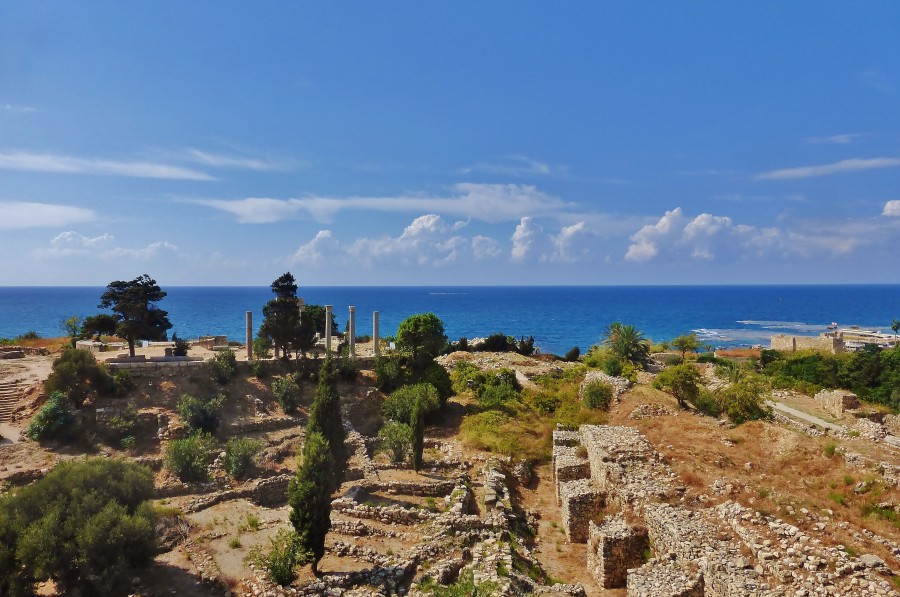
Beautiful Byblos, with the ruins and sea view.
That day, in Byblos, I also had a nice surprise because a local woman invited me for tea in a nice restaurant. I was honestly surprised that it was rather the man who should invite the woman. But she just wanted to talk, as if she were curious about my story, where I was, what I saw and what I think about Lebanon. Of course, we also talked about immigration policy in Europe, and she, as a Christian, said that Europe was cutting her own life and Germany, taking millions of Muslims, would soon regret it. I was glad that I was able to have such a sober conversation with a woman that, for example, with an English woman would probably be impossible, without being accused of “racism” or “xenophobia”. That day I met two women who were nice to me. What a relief, especially after many pointless conversations with the inspired Jewish lies of English women, to the level of their own genocide.
I returned to Beirut from the main road. You can also try to stop any car going south.
A one-day trip to Tire and Sidon
(A Brief History of Israel’s Occupation of Lebanon.)
That day I wanted to see two important places south of Beirut. First I went to the Cola station, which took me to the bus station in Sidon. My journey took less than an hour because the distance between these two cities is only about 45 km, and I lost the most time in Beirut traffic jams. I paid 5000 lire for the ticket. At the station in Sidon, I had a cup of tea and saw the entire collection of junk at the station, but soon got on the next bus to Tire. I wanted to see Sidon too, but I thought that I would start my tour from a further city from Beirut. It is less than 40 km from Sidon to Tire, which I covered this time in 45 minutes. On this stretch of my way, I saw many military bases, concrete blocks with Lebanon flags, a lot of barbed wire and also banana fields. I understood that the stretch between Sidon and Tire was a “sensitive zone” as I call it, and until a few years earlier Tire was not accessible to tourists at all due to its proximity to Israel and the fact that Israel had occupied southern Lebanon for 22 years. In Tire, on the other hand, there was a great Israeli military base, and the people living there remember well the terror associated with those times, including the Israeli air strikes. I’m not saying that Muslims are holy, but Israel never was either, and in this case it was Israel who attacked Lebanon, while Hezbollah defended itself.
First, Israel occupied and terrorized Lebanon for 22 years from 1978 to 2000, and then launched a war with Hezbollah on Lebanon in 2006. Israel then killed 1,200 Lebanese and injured more than 4,400, leaving behind enormous damage to infrastructure, which made southern Lebanon closed not only to tourists but also to Lebanese. In my opinion, however, the most comical of all was the UN peacekeeping force stationed in the region in 2011 and consisting of 35 countries. I personally make UN soldiers extras, as they have done absolutely nothing to end Israel’s aggression on Lebanon. To this day, southern Lebanon is armed to the teeth and overcrowded with intelligence agents, and in my opinion it is a war zone ready to repel a renewed attack by Israel. In southern Lebanon, especially in Tire, be careful how you take pictures. Once, I photographed the mosque completely innocently, and immediately an armed soldier approached me and told me to remove the photo because there would be a problem. I replied it was just a mosque and he said it was also a military base. South Lebanon has many surprises.
I went this Tire Mainly to see two complexes of attractive Roman ruins of Al-Mina and Al-Bass. I am not an archaeologist or art historian, therefore I will express my own opinion.
Al-Mina , also known as Al-Medina, or simply “Roman ruins” is around 800 BC. To date, however, archaeologists believe that Al-Mina was a Syrian. Once there was a Phoenician shopping center, while on the day it was greeted by the Mediterranean coast. Al-Mina archaeologists have managed to bring out many mosaics as well as pitchers and everyday objects. For me, I am staying on a beautiful beach.
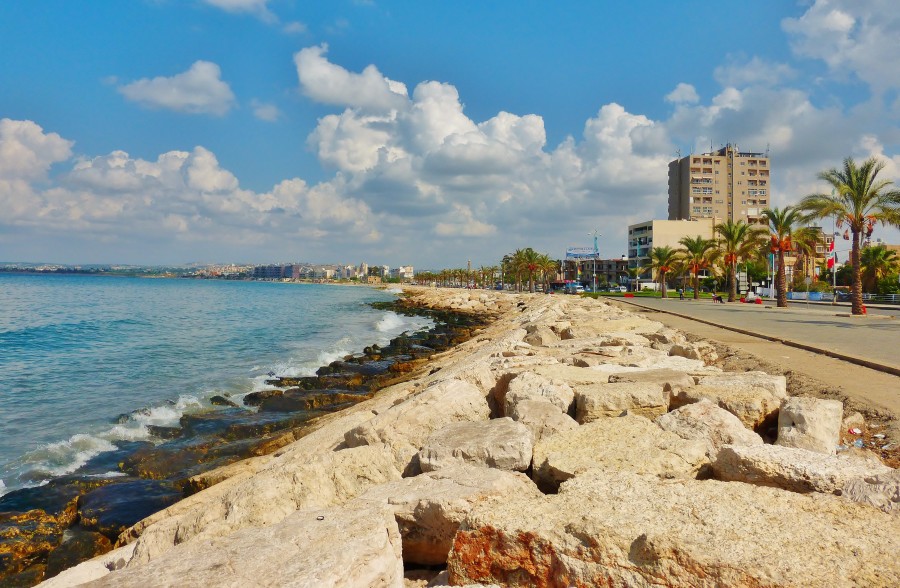
Lebanon; Corniche in Tyre.
Then I went through the city to the second ruin, which is Al-Bass. Al-Bass is a much larger complex of ruins than Al-mina, and also better preserved. Archaeological finds suggest that this large Roman city dates back to the 2nd-4th centuries. In Al-Bass there is a necropolis, a cemetery with ancient sarcophagi decorated with bas-relief and marble, and a 6th-century chapel with a marble floor. What I liked the most was the magnificent triumphal arches, most likely built in the 2nd century by Emperor Hadrian. There is much more to see in Al-Bass than in Al-Mina, as there are whole objects, rows of arched walls and marble roads.
I believe that the whole thing should be better prepared for tourists and both objects should be restored, but they are still very attractive ruins in a very “delicate zone” of Lebanon. About 6 km from Tire, there is also a 2nd century Roman hippodrome that can accommodate 30,000 spectators.
After seeing the Roman Ruins, I went to the vegetable market to have better contact with people, and then walked along the Corniche, which is the seaside promenade. I also sat down for something cold to drink under the palm trees. People were very interested in me and sometimes also suspicious, because they do not often see tourists in this part of Lebanon. Besides, the surroundings excited the imagination. I saw propaganda shops promoting the spiritual leader of Iran – Ali Chameini, and the flags of Hezbollah, armored vehicles of the United Nations and, unfortunately, poverty and a lot of rubbish in the side streets. I also went to the fish market in the port of Tyre, but people reacted strangely to the sight of me, as if there was something wrong in the air. In Tyre, it was noticeable that people could sense strangers right away, and that due to a long war, it was a city behind the rest of Lebanon. If I were to summarize Tyre in one sentence, I would say that it is ‘Hezbollah’s Shi’ite base by the sea, among the Roman ruins.’ Tire is a very good experience and I would rather not recommend it for a honeymoon.
The most famous attraction of Sidon is the Crusader Castle built on the sea in 1228, known in Lebanon as Qala al-Bahr. He misses that the Crusaders built him on the island 80 meters from the shore, the Arabs were so nice that they connected him to the mainland by means of a embankment. The castle consists of two parts and the main courtyard, as well as two main towers, from which there is a nice view of the sea and the fish port. It was evident that the castle was strengthened by the Romans, but on the other hand, it can also be seen that the representatives of the “religion of peace”, brutally attacking the castle, destroyed it in many parts. In addition, the Ottomans have also built a mosque in the castle, as seen in the stone dome on the west tower. In my opinion, even if someone is in Sidon just passing through and is very in a hurry, I think that he must get off to see this castle. Certainly not be disappointed. I paid 4,000 liras for entry and in the winter months they close by 4.
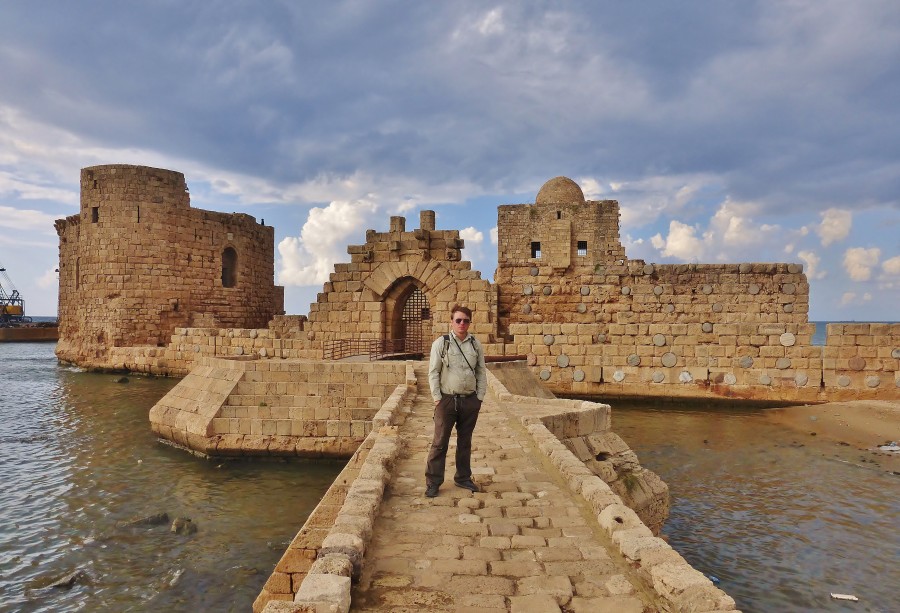
Lebanon; The Crusader Castle in Sidon, and a Crusader who survived until this day.
The second important monument of Sidon, on the mainland, is caravanserai named Khan al-Franj . This object is a seventeenth century shopping center built in a traditional Muslim way. It is a two-storey bazaar built in a square area, surrounded by traditional arches and chambers. The rooms on the ground floor served as warehouses for storing goods and stables, while the rooms on the second floor served as rooms for merchants. In the nineteenth century, the French consulate was here, but today Khan al-Franj is a tourist center and the flagship attraction of Sidon, often used for various events. (I lived in a similar hotel in Iran, but there was also a fountain in the middle). Free entry.
There are also ancient mosques in Sidon, which I think that every Christian traveler should see because of history. The first is the Great Mosque of Omar , demolished in 1291, and which originally was the church of St. John. In the middle there is an interesting architecture and on the outside there is a dome and a minaret. Unfortunately, this object was destroyed by “Jews who have respect for history”, which is why in the 80’s it was completely renovated. You can get to the Omar mosque from the bazaar. Another mosque is the oldest in Sidon, the Bab al-Saray mosque , built in 1201. It has a number of massive pillars and arches, and in my opinion this mosque is a valuable show of medieval architecture.
Besides, in Sidon I liked the fish market very much, where I went to see the catch, although for those who want to see fishermen coming in and fishing, I advise to come in the morning. The second place, which was beautiful not only because of architecture, but also contact with people, was of course a bazaar. I saw Arab sellers there, sweets and blacksmiths making furniture and carpenters who build furniture. There were also Palestinian flags because the entire Lebanese people are very political and hate Israel. Can we be surprised? People were very curious and that is why they had a lot of questions for me. I think the bazaar is a very good place to get to know the city and its people. You can sit here for hours while drinking tea, eating falafel in a bun and observe people. In addition, I advise you to go to the soap factory, although I have already sscow donated because I was in Nablus in Palestine and felt such a need.
After dark, I returned the last bus to Beirut. For those who have more time to South Lebanon, I advise you to spend time on the beach, come in the lemon fields, spend more time with people in the bazaars and go to the castle of Beaufort , about an hour from Sidon, through the town of Nebatiye. If I come to Lebanon again, I will spend more time in this part, even though I have seen all the monuments in one day. Lebanon is a very small country of small distances and straight roads along the sea, also in this country you can see a lot in a small time.
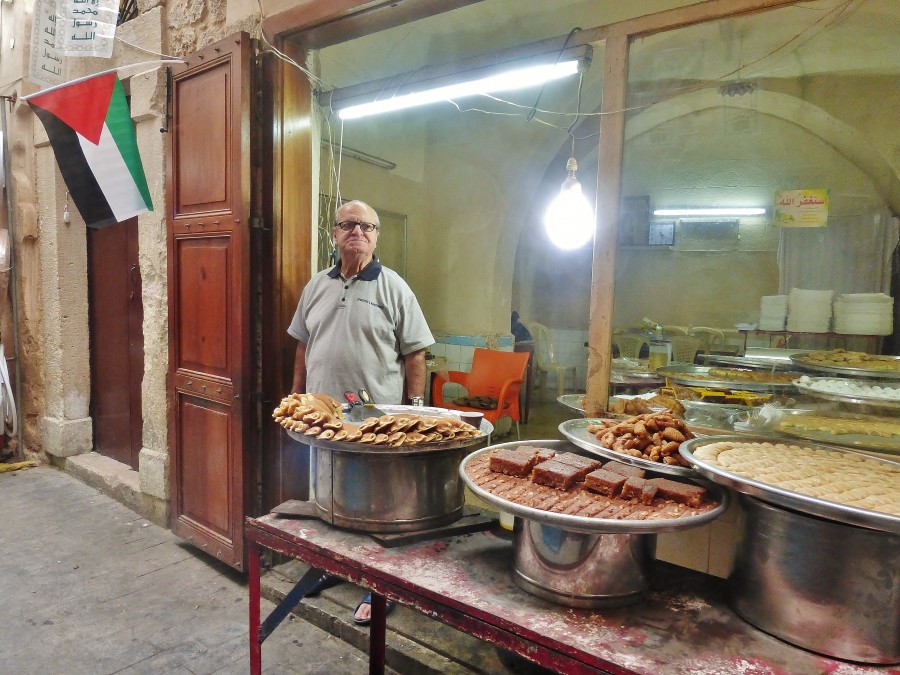
Lebanon; at a market in Sidon. Free Palestine is still alive in the hearts of a many people.
A trip to the Chouf Mountains
Lebanon is not just one route along the Mediterranean. It is also picturesque mountains and valleys located not far from Beirut, towards Syria, which I also recommend. One of the many attractions of Little Lebanon is the Chouf Mountains , where in addition to beautiful views, vegetation and caves, there are also ancient palaces and churches built on the slopes of the mountains. The Chouf Mountains are only about 40 km from Beirut, and in my case only 1 hour from the Cola station, and this is a beautiful region of Lebanon that has preserved its cultural, ethnic and geographical identity. In addition to the mountains and palaces, you can spend time in the company of Christian minority and druze, see cedar trees and try local apples, olives and grapes. There are about 20 small villages in the Chouf Mountains, of which there are a few noteworthy ones.
By combining the bus and hitchhiking I first got to the Beiteddine Palace , built by the best architects and craftsmen from Italy and Damascus. Beiteddine Palace was built with such a huge commitment to the smallest details that the construction took up 30 years, from 1788 to 1818. In 1840 Beiteddine was the seat of the Ottomans, while during the French occupation he served as an elegant office of colonizers in beautiful open air. The main entrance leads to the courtyard with dimensions of 107m x 45m, and around it are buildings with sophisticated architecture, with balconies, fountains and expensive furniture made of cedar wood. In addition, I also saw Arabic calligraphy, marble floors and mosaics on the outer walls. There is also a lack of well-kept gardens and stone passages finished with pillars and arches. The whole palace is a nice place to see. The ticket costs 7.500 lire, although I suggest you try to buy a cheaper ticket for 5,000 lire.
Then I hitchhiked higher up the mountain, and through a winding road I got to the castle of Moussa, who was a vision of one man and absorbed 60 years of work to finish it. Moussa Castle is stylized as a medieval one; has towers, cannons, wooden bridges and a moat. Moussa Castle also has exhibitions of people’s lives in the Middle Ages, showing everyday activities such as making silk or picking grapes.Behind the history of the castle is a sad but moving story, because the originator, architect and builder of the castle Moussa Abdel Karim al-Maamari dreamed of owning his own castle as a 14-year-old boy.Moussa was known in school as a dreamer, which he was beaten by the teacher and ridiculed by his colleagues, but he never gave up and finally, in 2005 he finished his own castle on his own land. In my opinion, closing Moussa is a good addition to the journey where the visitor will not be bored, but you can see that this object is stylized medieval, even if it is due to the imitation of stone tiles. The entrance costs 10,000 lire.
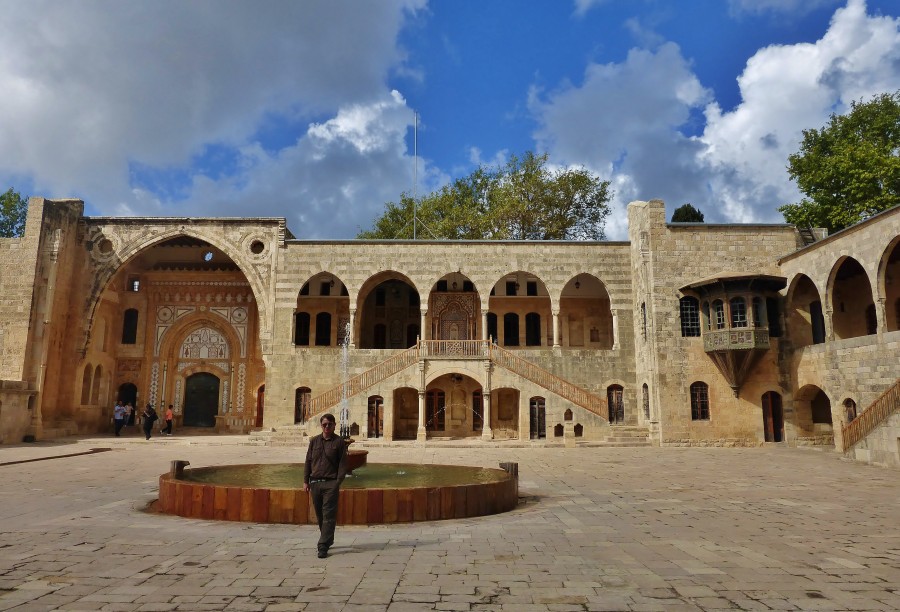
Lebanon; Chouf mountains- in front Beiteddine Palace.
Then I drove another hitchhiking even higher in the mountains, and after 2km from Moussa’s castle, I got to the Ottoman town of Deir al-Qamar . Between 16 and 18 century, Deir al-Qamar was the capital of the Emirate of Lebanon, but today it is a historic town located 800m above sea level, because of its stone houses with red tiles and buildings from the fifteenth and seventeenth centuries. Although today we can see the historic mosque, synagogue and church in Deir al-Qamar, today is a Christian city. Visits should start from the courtyard of Dana Chamoun , with a spectacular fountain. “It is the center of the town and a popular meeting place and events. To the west of the fountain is the Fakhreddine Mann Mosque, built in 1493. Noteworthy here is the minaret with the sides and the verses of the Koran on the wall of the mosque.Behind the mosque is a bazaar with several shops and Silk Khan, with charateristic arches, built in 1595, and on its eastern side there is also the Fakhreddine Palace , built in the same style in 1620.
Other sites that are found in Deir al-Qamar are Youssef Chehab Serail from the eighteenth century, followed closely by Sadet al-Telle church from the fifteenth century. It is still a functioning church where the arches in front of the main entrance and the bell tower with the Virgin Mary at the top deserve attention. Deir al-Qamar is therefore a small town but there is still a lot to see. Besides, I do not want my readers to think that in Deir al-Qamar there are only cold monuments and live souls. Life is also here, you can eat dinner and stay for the night. Nights are cold, so I advise you to dress warmly.
From Deir al-Qamar I went by two hitchhikers to Barouk , right at the gate of Cedar Nature Reserve , to see the trees that are on the flag of Lebanon. It was already dark and I did not have a hotel, so I set up my tent before entering the reserve and went to sleep, but it was so cold that I could not sleep. So I went down 150m down to the restaurant to drink tea and describe my travel memories. I also admit that I was not prepared for the night in the tent because I did not have a mat, and the older I am, the more comfortable I am. The wind blew and it was raining and it was a hard night at a height of about 1000 meters above sea level. In addition, it was so cold and windy that I fell asleep only at 8am and woke up at 11, because then the sun came out and it was warm.
(Last time I slept in a tent in Iran , under Kaluts, and just in a storm. This time it was not so dramatic but it could be a bit warmer.) As soon as I woke up and got up from the hard way, I immediately folded the tent and went to buy a ticket 7.000 lire, and walked into the park. Unfortunately, from the entrance to the cedar trees there was still 6km uphill, which is why I got there two hitchhikers. There are many trails in the park where you can see cedars but I did the most important one. I felt tired of constant transport, cold night in a tent and now climbing. Cedar Nature Reserve is located on 2,762 hectares, at an altitude of 1000m -1200m above sea level, and this is an effort, which is why people come here in groups by cars from Beirut. It is about 52 km southeast of the capital Lebanon. The trees themselves were obviously beautiful, and I think that everyone who travels around Lebanon should see them at least in one park.
I still have one sentence to my mind that I heard from the manager of Cedar Nature Reserve, but I have no way of knowing if it is true. Well, I asked him why the cedar trees in Lebanon are only in reservations at high altitudes? I thought that when I came to Lebanon, cedar trees would also grow on the roads in the mountains by the roads and I expected people to try and plant them in Beirut. I said that for a country where the cedar tree is its symbol, I have not seen a single cedar yet. Why are there so few of them? He replied that there had been a lot of cedars in Lebanon, but the French had stolen almost all of them. That sentence also let me understand what the Lebanese think about the French.
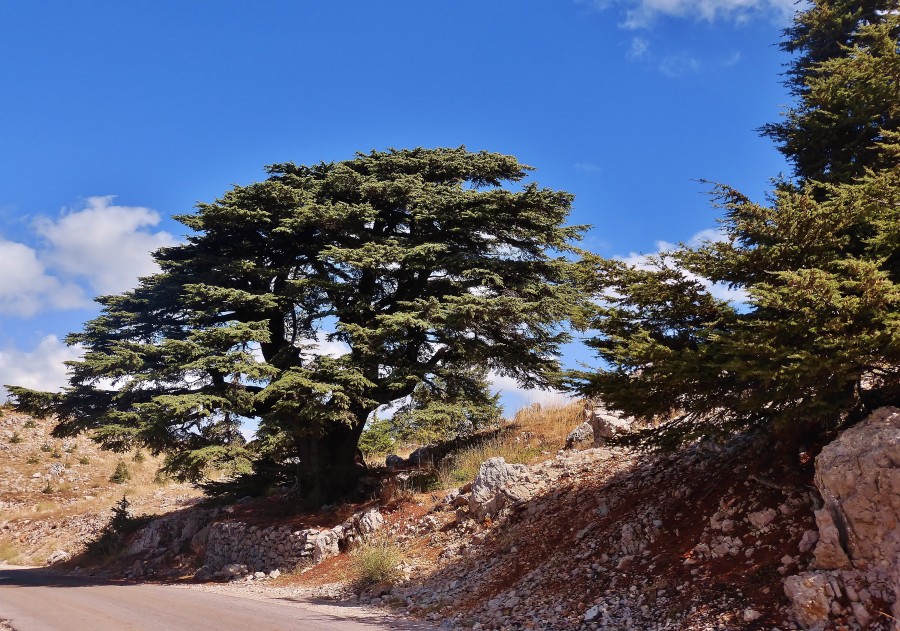
Lebanon; Chouf Mountains – cedar tree, the symbol of Lebanon.
Adventure in transport from Barouk to Beirut
(The story of the road during which I saw: Baakline, an unused strategic airport where the Russians dropped their weapons, Moukhtara, military bases, Jezzine, an interesting conversation about Israel and Iran.)
After years of traveling to many countries, I noticed that hitchhiking is extremely important to me because it allows me to see places that I did not even know and in the company of people who are sometimes very interesting and change my view of many things. There was no different in Lebanon. From the park gate, someone first gave me a ride to the gray-busted town of Barouk, where I ate a kebab. From there, another hitchhiking took me a few kilometers to the town of Beiteddine, from where I drove next cars. I only knew that I was in Lebanon in the Chouf Mountains, and about 40 km from Beirut. Once I was also very happy Lebanese, who told me that he likes tourists and likes to travel around the country, because every time they have something interesting to say to him. I also took a sightseeing tour on board a 35-year-old car. My private Lebanese drove me even to a small village on the top of the mountain where there was an unused airport , which the Russians used to drop their weapons.
Then we went down, driving through the little Baaklen, and then our route led through empty winding roads, and through the small town of Moukhtarawhere I got an old castle. Immediately behind Moukhtar, my driver dropped me off at the military base, which meant that I remembered the true nature of Lebanon again. I saw machine guns, concrete blocks and barbed wire, which I think should start showing up on the Lebanese flag as well – that’s what it is here.Of course, the soldiers had a few questions but quickly let me go, seeing that another hitch-hiking was coming up. Anyway, they did not want me to look at their equipment.
This time I was taken to Jezzine , a small town on a huge cliff, near which there are mountain trails, waterfalls, lakes and beautiful views. Jezzine is one of the main tourist centers in southern Lebanon, mainly due to beautiful views and beautiful nature, but also due to its interesting architecture and rich handicraft.Jezzine is today mainly a Christian mission and therefore has several historic churches, such as: Saydet el-Yanbou from the late eighteenth century, and the church of St. Anthony and the church of St. Józef from the 19th century. Nevertheless, Jezzine is called the “City of Waterfalls” and I advise you to stay here for more than one day to get to know the beauty of the region. In Jezzine, I stayed all day walking around, and in the late afternoon I went to a political festival where I took pictures of happy girls.
Jezzine is only 40 km from Beirut and 22 km from Sidon, which means that even people who do not travel in the Chouf mountains can go on a one-day trip.
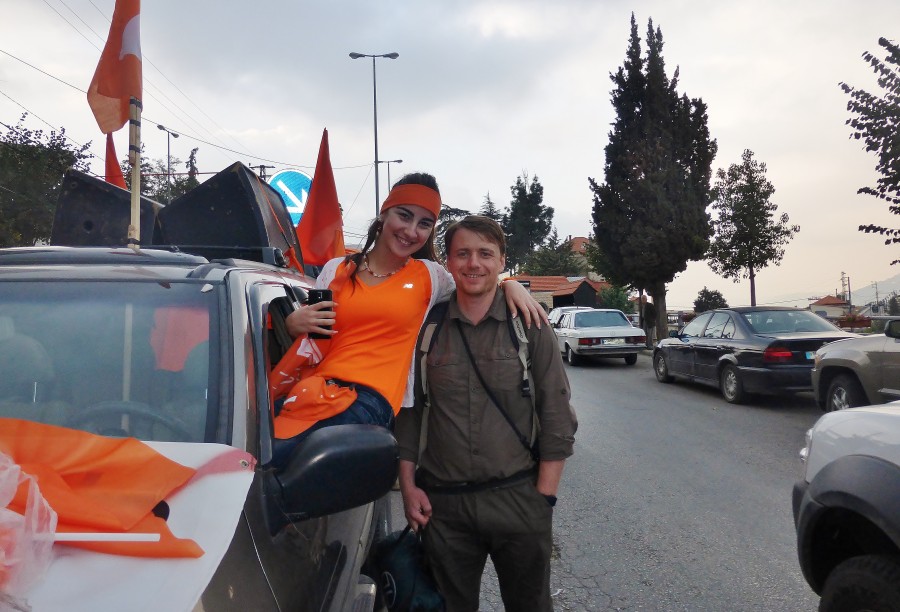
Lebanon; a nice welcome by a pretty kitty. Lebanon.
My way from Jezzine to Beirut was also interesting. When I left Jezzine, for a while I was still strolling to look at the cliff and mountains, but soon I was lucky because there was a car that took me to Beirut. This time the driver was an elderly man who talked to me about politics. He said that according to him, the Jews rule the world, while the Arabs are nothing and they have no meaning. He also said that in his opinion, Israel and Iran are secret allies who only pretend to be enemies to laugh at stupid Arabs in order to use them later. An interesting story.
A trip to the Mleeta war museum
This time I traveled with a friend from Germany, who was also interested in the subject of war against Jews.First, we went to the city of Sidon and then went the next bus to the southeast. The driver dropped us off somewhere on the road, from where we went to the town of Habbouch . After reaching Habbouch, we immediately noticed the posters of Shiite leaders and support for Syrian president Bashar al-Assad. Soon after, we were unwisely accosted by one Arab, because he did not like the fact that we were taking pictures. However, after a little scuffle, someone more civilized approached us and said that this town and the whole area are controlled by Hezbollah. So we went together to the pizzeria, where he looked deep into our eyes, saw our passports, took pictures of us, asked a number of questions and also looked at the pictures in our camera. Then they consulted each other and when they decided that there was no reason to suspect, the Hezbollah soldier gave us peace and we ordered tea.
We told him the truth that we were going to see the museum of war – Mleeta. Anyway, going to the museum, you have to cross the Habbouch and see the Shiite banners at the roundabout, which are marked in English as “interesting for tourists”. So it should not be a surprise for Hezbollah. I was not interested in Hezbollah because I am Polish and they know nothing about Poland. However, they were very excited by the German and after they checked us out, they had a friendly conversation with him. The German then told me that his country is very popular in Muslim countries, because everyone wants to go there, to which I replied that I am happy that I am from a black hole called Poland. Then we hitch-hiked for about 6km until we got to the top, to the museum gate.
The Mleeta Museum was opened on May 25, 2010, on the 10th anniversary of the march of Israeli troops from southern Lebanon, and in memory of Hezbollah’s victorious fight over Zionist Israel, at the top where fierce battles were fought. You can see there a lot of machine guns, heavy artillery, trenches, barbed wire, rockets, figures of yellow-haired people giving orders over the phone, and the Israeli tank Merkava, which Hezbollah took over during the fighting. The Merkava tank is located in a spot on the fire line, with several wrecks next to it, and what is important, the Israeli tank has a barrel wrapped in a bow and Israeli bullets and helms lying around, as a sign that Hezbollah does not want war and that Israel has collapsed. There is also a film showing the history of the occupation of Palestine without a Jewish narrative, and the speech of Hizbullah leader Hassan Nasrallah on Israeli terrorism, and that Hezbollah will not tolerate Jewish occupation. For me, the attraction was a tunnel in the rock, where there was a kitchen, rifles and communication equipment, where the tourist could feel like a Hezbollah warrior. Leaving the tunnel, I was surrounded by rockets, sandbags and barbed wire, which also gives a sense of realism.
Besides, the museum of Mleeta is a great place for the whole family, because you can also see posters showing Israeli weapons and photos of Israel’s nuclear power plant in the Negev desert. Children, on the other hand, can play with anti-aircraft guns, raising and lowering them to destroy enemy planes. At the very end, I went to the top of the mountain from which Hezbollah was defending itself against the Israeli invasion and where the flags of Hezbollah, not Israel, are today. I also drew much attention to quotes from Israeli leaders who themselves admitted “that Israel’s army, which had hitherto been considered indestructible, was forced to withdraw for the first time in history. Hezbollah has proved that they are Arabs of a different kind. ” I suspect that if Israel won this fight, today this part of Lebanon would be the second Golan Heights that America would immediately recognize as “the historic homeland of the Jews” – but I leave this speculation to specialists.
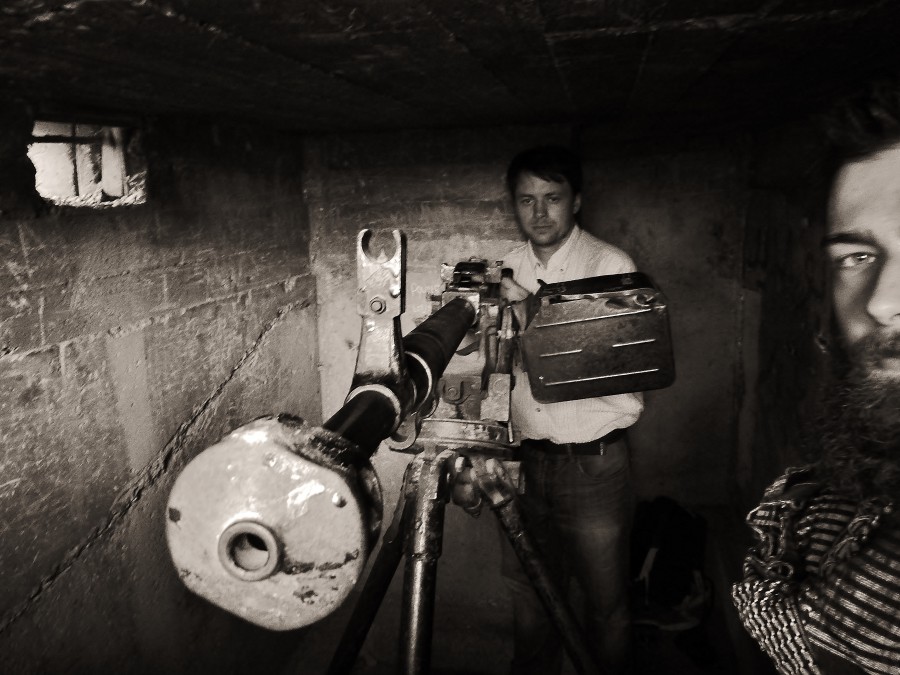
Lebanbon; I will have to buy myself such cannon, when I become a British politician. This is how I understand “democracy”.
The Mleeta Museum is visited by around 300,000 people a year and continues to grow. In a few years a city will be built there with slides and pools as well as a cable car. I also recommend the official website of the museum https://mleeta.com/mleeta/eng/. I liked it very much and I consider it a must to travel around Lebanon. On the way back we were transported by Hezbollah members to the main road, then another hitchhiking to Sidon, and from there we returned to Beirut for 3000 lire. Me and my German friend also had an interesting conversation, because on the way back we talked about Jewish crimes against humanity, and about the final solution for Jews who did not come true. After the German’s will, he opened himself on the subject of enormous wrongs that the Jews inflicted on the Germans and which could not even be spoken in Germany. Then, however, we ended the conversation with jokes about Auschwitz and immediately improved our moods.
Tripoli – the northern capital of Lebanon
Tripoli is the ‘northern capital of Lebanon’, and the traditional Arab city, where the most ancient archaeologies from the Mamluk period, after Cairo have survived. There is also an impressive citadel, traditional bazaar, baths and an attractive harbor with al-Mina palm trees. Tripoli, however, although it is very attractive for travelers, is shrouded in propaganda of fear, which meant that only 2% of all tourists traveling in Lebanon decide to go Tripoli. Western media made sure that people living in Tripoli should be introduced as terrorists, but on the other hand, no one explains that it was Israel that occupied Lebanon, and that the lighthouse has no light, because the Israeli aviation has always “extinguished” it. I leave my readers to judge who is a terrorist here. I will only add to not be afraid of Tripoli and necessarily go there. I got to Tripoli from the Charles Helou station from Beirut and the ride lasted only 1.5 hours and it cost me 8,000 lire. The distance between Tripoli and Beirut is only 85 km.
When I left the bus station, I first saw a beautiful Arab woman in a ticket office, who was smiling at me like a hot cat burning in the Lebanese sun. Nice smile, good ass, just a good cat. Soon, however, an Arab stinking Arab came up to me and wakened me from waking in a loud, “how can I help” dream, to which I replied that I was a tourist from Poland and I was going to the Haddad hotel which I ordered earlier. Arab was giving me so nice that he took me on a moped and drove me near the hotel, and he did not even want money from me. When I got out, I quickly understood that Tripoli would be a beautiful experience for me and an attractive culture shock in a Muslim city. People were not used to seeing the tourist and reacted nervously when I pulled out the camera, and I felt like a little animal in the zoo. However, it was nice. Some of them drank tea and coffee on the street with the Lebanon flag behind them, and others sold things on street stands. As it is in the Arab country, the whole street is a bazaar and it is always close to the mosque. The Haddad hotel was the cheapest in town because I only paid $ 10 for a large room, and I also had a shower and herabata from time to time. I lived near a small park and a clock tower.
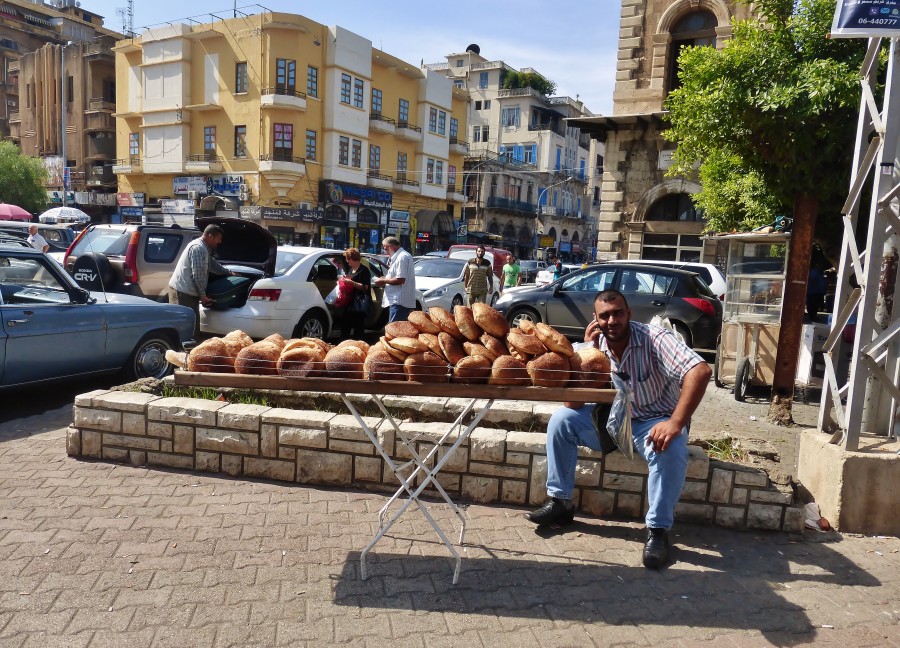
Lebanon; a bread seller in Tripoli.
As a city of such historical importance, Tripoli has many interesting objects. There are ancient mosques, baths, Muslim schools, traditional bazaars with characteristic arches and Muslim calligraphy, there is also a great citadel, a port with a funfair on the island – and do not forget about people who are a very interesting picture of reality. Tripoli takes time, and the bazaar itself is a great place to get to know the character of the city. Tripoli can buy gold, try freshly squeezed juices and eat from street vendors, and at the end of the day go to a relaxing bath. There are also armored cars, barbed wire, concrete blocks and people who did not like that I took pictures of some objects. So I can feel the nervous situation.
The most famous and dominant object is the Citadel Raymond de Saint-Gilles , which occupies 10,000m². Cytadelata, was built by the Crusaders in the 12th century, after Raymond Saint-Gilles entered Tripoli in 1102. Over the next 180 years, this fortress built on the Hill of Pilgrims (named by the Crusaders) was a good observation and defense point. Unfortunately, everything has its end, because the Crusaders exercised power over Tripoli, until the Mamluk dynasty did not conquer the castle and destroyed it in 1289. Today this fortress is destroyed but still in a good enough condition to be worth the trip, and it is a combination many styles, including the Ottoman ones, because the Ottomans have taken Tripoli Mamluk.For example, the main gate was built by the Ottomans, and the bridge behind it by the Crusaders. In addition, the photo shows the Old Town, the Abu Ali River … ..and armored cars and concrete blocks. I also enjoyed the climb to the castle, because first I went there through the Old Town and bazaar, where I bought, among other things, grapes and nuts in honey, and then I went higher, through gray streets, car wrecks and housing estates kept in this climate.
Then I saw several mosques and medres (schools) in the Old Town. First, I saw the Great Mosque , also known as Jami al-Kabir, completed in 1315. This mosque is a combination of the Mamluk and Crusader styles, because this object is connected with a sad history for Christianity. The Great Mosque was built on the rubble of the Cathedral of St. Mary. Even the minaret was converted from the bell tower. Next to the Great Mosque, there is the Al-Qartawiyat Madrasa Muslim school, which is attractively decorated, because it has nice pillars, beige and black walls and carefully decorated entrances by means of bas-reliefs. Inside, there is a room with an oval roof in the shape of a nest of bees. This object dates from the fourteenth century and historians suspect that it could also be built on the rubble of the church.
Outside the center of the Old Town, I also recommend smaller mosques, which any tourist will come across sooner or later. Besides, there are signs for tourists, showing where the objects are located. You can go to the madrasa Al-Muallaqu , built in the sixteenth century. The mosque has a nice garden and is located on the second floor of the building, thanks to which it is called the “hanging mosque”. Other objects that I recommend is also the madrasa Al-Tuwashiyat , from 1471, which is also partly a mausoleum, and as in the previous mosque, here also has rocks arranged in alternating colors; White and black. Also, if you like mosaics, large onion-shaped domes, minareries and large spaces, I recommend combining the medresa and the mosque, which is Burtasiya from the 14th century.
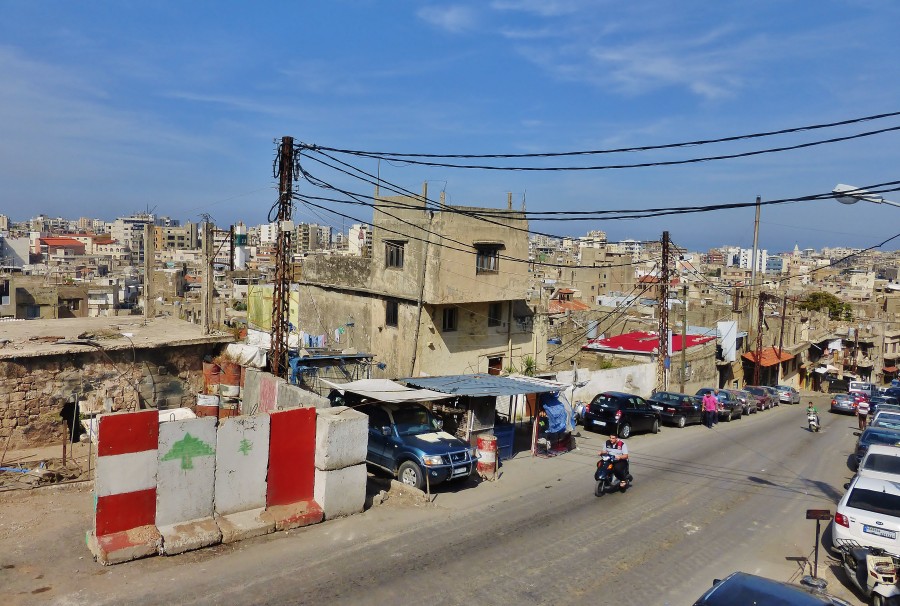
Lebanon; a street in Tripoli.
Tripoli also has several ancient bathhouses that are open and able to put even the most tired traveler in a good mood. In each of them you can see carpets, Ottoman lanterns and many attractive items, enjoying the eyes of travelers. I went to Hammam al-Abed , where for 35,000 liras (around $ 20) I had a cold and warm shower, whole body soapy, a massage on a marble floor, and scraping the skin with a sharp brush. At the end, of course, I was once again treated with a bucket of cold water, but it was very nice, and I liked it the most when I had a very close encounter with the floor and the masseur massaged my back and legs.The al-Abed bath was built in the seventeenth century and still retains its traditional charkter. It has ceilings connected with vaults and in the domes there are openings, thanks to which the sun gets inside and air flow is possible. At the very end, the Arabs wrapped me in white towels, including one on my head and I got Lebanese tea with mint. It was great and I think that a visit to the Lebanese bath is the responsibility of every traveler. Unfortunately, she did not massage sweet pussy with big breasts but a fat, bald immigrant from Syria with hair on her back, which of course I gave a tip afterwards. WARNING! It is necessary to give a tip. At least $ 2. The al-Abed bath is open only to men.
Late in the afternoon of the same day, I went outside the center of Tripoli to see the Taynal mosque , built by the Mamluks in 1336. It took me some time to find it but I think it should be seen, because it is built in a traditional way for Mamluks, it is surrounded by a large garden and palm trees, has large green domes and an attractive stone work and Arabic calligraphy. (Unfortunately, this mosque was built on the rubble of the church.) My walk to the Taynal mosque was also interesting, because I was walking through the rows of shops and car repair shops, where people stared at me, and on the few doors I saw German flags. Well, “half” Arabs are already in Germany, and Mercedes has a reputation.
The next day I visited less. That day my plan was to spend time with people in the bazaar and go to the port. People in the bazaar were very interested in me, and I saw that they had a topic to talk to each other right away. The most popular European country for Arabs is of course Germany, that’s why everyone thinks I was also from Germany, When I said that I was from Poland, not everyone even knew where the country was. A few Arabs came up to me saying something in German, others that they had families in Germany, and one came especially to me that “this morning 200 peasants went to Germany”.I said, “I can not have a word” racism and xenophobia “. I drank juices from freshly squeezed fruit, I was on coffee in the street club, and I bought a few things. I spent the time talking to people who were born businessmen. Women also watched me, only discreetly.
There are however places on the Tripol bazaar that travelers should find. These are historic, built-up places with pillars and stone arches in the bazaar, referred to as khan and souk, which are also vibrant with life and where One of them is Khan al-Askar from the fourteenth century, which was built as a base for the turtles. He is another Khan al-Khayyatin, the so-called “khan tailors, built in the fourteenth century.” Another place, also built in the fourteenth century, is the Souk al-Haraj , where you can buy things for the home, such as pillows and mattresses, and where You can not forget about Tripoli, I said, I think it’s a lot of you. to find these objects in a good place. Fortunately, every seller of bread is a great place to meet people. , see them at work and find out what they think about certain topics.
In the afternoon I got into the port called Al-Mina . The port is always very nice. Here I was not looking for monuments, just walked around the shore, I looked at the street vendor. The port is a very relaxing place. Being in the port, who is a defensive structure built by Mamluks in the fifteenth century, and can sail to the Palm Islands which is a nature reserve, located about 5.5 km from the shore. I am looking for a place to stay, but I will not be able to go to the island. I went only on the bridge to a small island. In addition, there is also the art gallery Beit al-Fann , but that day was closed. In the port I stayed a dusk and then I returned a taxi to Tripoli, from where I was going to the Arab pastry shop. I remember that the Arab woman who worked there was afraid to sit close to me, because she had a harsh husband.
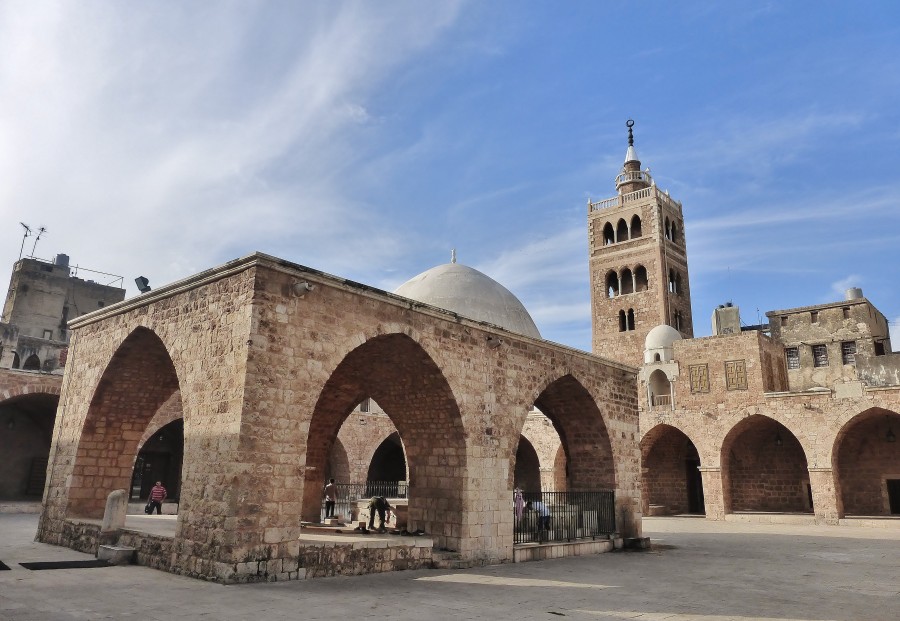
Lebanon; the Great Mosque of Tripoli.
On my last day, I went to see the Great Mosque and buy fresh juices, which are Tripoli’s specialty. I admit that although I did not expect it before, Tripoli turned out to be the best of Lebanon.
Transport from Tripoli to Bcharre
1.5h for 5,000 lire. The last part of the trip was the best because of the mountain views.
Qadisha Valley
The Qadisha Valley is one of the most picturesque areas of Lebanon, extending for approximately 50km. Qadisha is a mountainous area with caves, waterfalls, and cedar trees in the higher parts of the mountains. The Qadisha Valley is a wild area with many mountain trails that can be visited at any time of the year, although spring and summer are most picturesque when the mountains and valleys are covered with flowers. The Qadisha Valley is inhabited by Christians who began to come here en masse when the lands of what is now Lebanon were invaded by Arabs from the 7th century onwards. Then the Christians found safety in more inaccessible areas. The caves and churches they built in the mountains inside the ravine gave them shelter from Muslim invaders. When UNESCO included the Qadisha Valley among the riches of world culture in 1998, it said that “Qadisha is one of the most important early Christian settlements in the world.”
While I was in Dolni Qadisha, I had to go hiking along the beautiful gorge full of plants, caves and churches.
Bcharre and surroundings; day I
Bcharre is a small mountain town inhabited by Christians, which is probably the most picturesque place in Lebanon. It lies at an altitude of 1500m above sea level and has a population of about 13,000. Bcharre is surrounded by snow-capped peaks, caves, beautiful churches, cedar trees, and in the gardens. For me, Bcharre was a very attractive base from which I have been traveling to Qadisha Valley, and I also advise other travelers to make sure they stopped here. I stayed at the Tiger House for $ 10. In Bcharre, it is impossible to get lost, but Saba, who dominates the city, set it as a landmark. There are also buses to Tripoli, Sidon and Beirut, as well as banks, shops and restaurants.
I did not do much on my first day in the valley. I only went to a cave called Qadisha Grotto, beautifully located in the middle of the rocks. I got to the Qadish Grotto with two hitchhikers from Bcharre, in which I drove on a truck, on bricks. After leaving the bricks, I walked for some time along the dirt road, and then, after settling the bill for 5,000 lire, I was let in. Qadisha Grotto was discovered only in 1903, and has been a popular tourist destination ever since. This cave is less than Jeita Groto. So far, 778m of the cave have been crossed. Nevertheless, it’s possible to go deeper. There was a rushing stream inside, and there was a safe road on one side.In Qadisha Grotto you should also pay attention to stalactites and stalagmites, but I liked the view of the place. I treated the entrance to Qadish Grotto as the accomplishment of my adventure. It is also nearbyReserve for Tannourine Cedar Trees , but I did not go there. Cedar Reserve in Barouk. Nevertheless, it’s a pity I did not go. On the one hand, I felt tired of traveling, and I did not feel very well, on the other hand. Bcharre I understood my mistake.
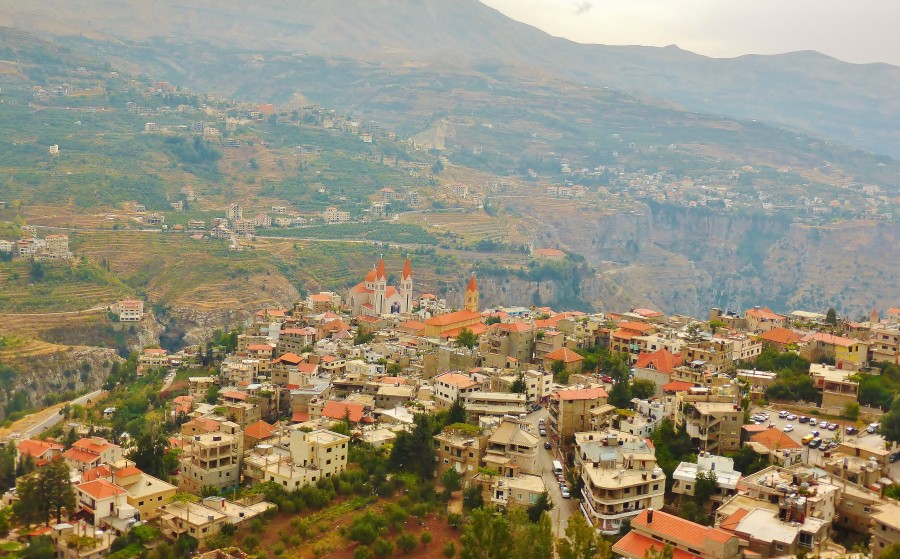
Lebanon; the view of Bcharre.
After returning from the cave, I went to Bcharre, I bought grapes and I was on the kebab. However, I felt so tired that I fell asleep quickly in the pub.
Bcharre and surroundings; day II – Mountain trip to caves and churches
The mountain town of Bcharre and the view of Qwisha valley. That day I woke up early in the morning, because I wanted to see Qadisha Valley and there is a monastery, and I advise future travelers to devote all day to it. From Bcharre I got hitchhiking to the exit, where there was a beaten road, and I knew that I was going on a multi-kilometer trip down the valley. I usually went alone, but sometimes hitchhiking helped me.
First, I saw the Maronite church, Deir Mar Elisha, of which the first written evidence dates back to the 14th century, while Lebanese priests of the Maronite Order have been using this facility as a church since 1695. This church also houses a museum and lots of items showing the history of the place. The Elisha Church is very ingeniously built on a mountain wall, making it part of the geology of the Qadisha Valley, making it one of the most spectacular structures in the region.
Then I continued walking along the mountain path, and throughout my trip I had picturesque views of the mountains, conifers, red earth, rocks and caves. It was a great, beautiful day, which was also interesting because of the churches built on the slopes of the mountains. I soon reached the Deir Qannoubin Monastery, which is also built into the rock wall and is part of the landscape. Deir Qannoubin is the oldest monastery in Qadisha, as it comes from Byzantine times, most probably from the 4th century. This monastery was the seat of the Maronite patriarchs in the years 1440-1790 and has an interesting painting depicting the Coronation of the Virgin observed by the patriarchs.
Then the most beautiful part of my trip started, towards the Hawqa monastery. I had to open the area, and the mountain trail decorated with coniferous trees and protruding rocks, until I reached the Hawqa monastery, built into the cave. Here, I spent more time exploring and observing the bottle with water. Sadyet Hawqa is a small chapel built on the 13th century. Personally, I liked this church very much because it could not be seen, hidden behind the trees. Tired travelers and will find it useful to know That Sadyet Hawqa is located 4.5 km from Deir Qannoubin, on a wild road, while from a Hawqa Bcharre it is 6.5 km, and unfortunately it is sometimes a way uphill.
Then I went on my way back, and then I was lucky enough to hitchhike to the main road. However, I did not want to go back to Bcharre, so I made one more effort to see more. By mistake I went to the village of Bqaa Kafra , where the man I met him, he was picture of John Paul II with him. I said that, of course, it was nice and I thanked him, I would not be a pope. From this village I drove the next road to Bcharre. Simon, or Deir Mar Semaan . This monasterry, was built on a cliff, was built and was the seat of Saint. Simon.You can see the frescoes there, but I do not think you can see the view of the valley. In the evening I returned to Bcharre via austop and I was so exhausted that I fell asleep immediately.
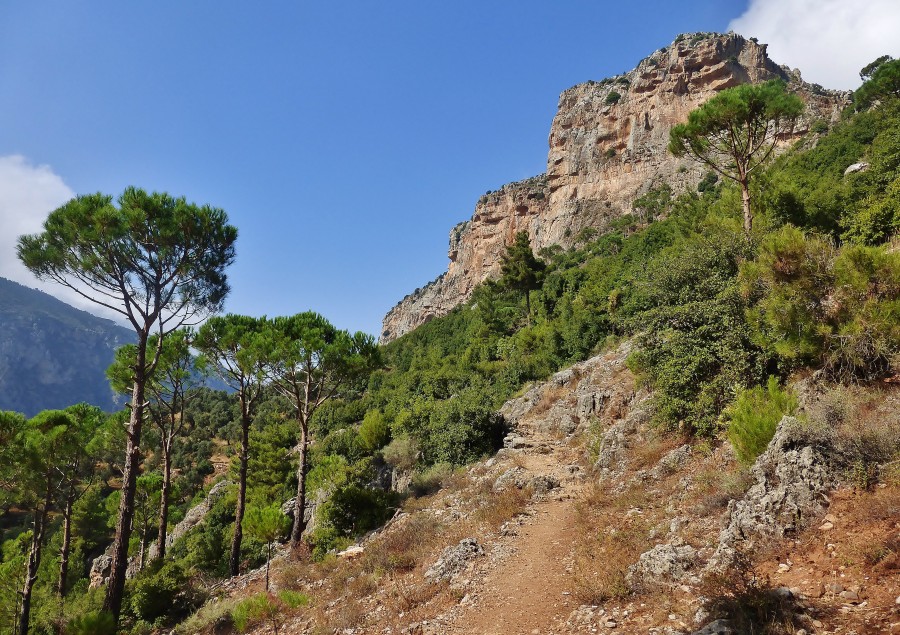
Lebanon; the natural beauty of the Qadisha Valley.
Bcharre and surroundings; day III – Mountain trip to caves and churches
On my third day in the Qadisha Valley, I went to the museum of the famous painter Khalil Gibran , who is also very much interested in learning about his life. The museum is more like a small house. In the church next to him is his grave. The entrance costs 5.000 lire.
Then, with a few hitchhikers, I drove down the valley to the Deir Mar Antonios Qozhaya monastery, built in the 12th century. This monastery is the largest of all and also, partially built into the cliff. This church is still active today because there are regular masses there, and besides, there are many objects of historic importance inside, including the first Arabic printing press from the 16th century, which priests use to this day during some mass. There is also a “cave of haunts” next to the church, where there are chains that for many centuries have been used to bind the mentally ill and haunted by the devil. In my opinion, this church was attractive and nicely composed in the mountain surroundings, but getting to it was not as adventurous as in the previous, because the access was very easy, on the asphalt road. My way back to Bcharre was very nice,because my grandfather lifted me with his old Honda from 1982, which barely traveled. He was a very nice man, and as the car was driving very slowly, I saw the area better.
If I was to summarize the Qadisha Valley only, I would say that it is really worth it.
Transport from Bcharre to Beirut
I got to Beirut in 2h for only 7,000 lire. The distance is about 110 km.
I was glad that I returned to Beirut, especially since I had to book a flight to Amman. Besides, I spent time talking with the Syrians about the war in their country, and I takled about my memories. They said they were surprised that someone from Europe could have such a sober and rational look at the situation, because all Europeans with whom they talked before had no reasoning. I said that it was because I was from Poland and I know the truth about the crimes of Jews, while in Western Europe these are the lost generations washed away by pro-Jewish propaganda above the possibility of repair.
The road from Beirut to Baalbeck
In the morning I had a small delay because I broke a padlock from the wardrobe in the room and the receptionist had to saw it. Then I quickly had to pack and finally I left the hostel. First, I went to the Cola station, from where I went to Chtaura, and then from there to Baalbeck. I will add that Chtaura appeared on the map only because it lies at the crossroads, but there is no point in staying there any time.
Beirut Cola – Chtaura, 1.5h, 5.000 lira
Chtaura – Baalbek, 1h, 3,000 lire
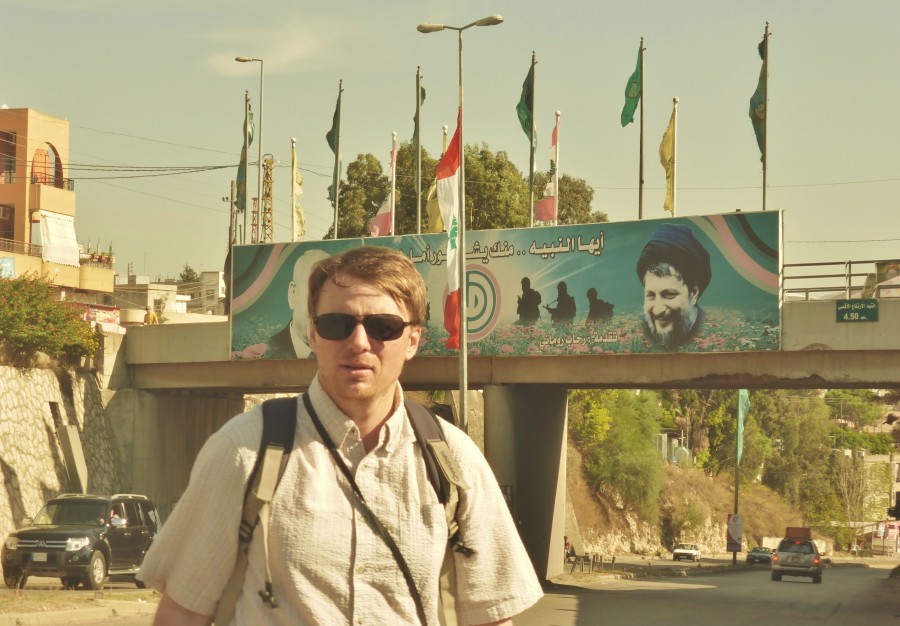
Lebanon; a picture of an adventure traveller.
Bekaa Valley
The Bekaa valley is an area of Lebanon along the border with Syria, which in some places lies at an altitude of 1000m. For tourists, Bekaa is known for the ruins of ancient civilizations such as Baalbek and Anjar, and because of the famous wine cellars and beautiful naturlanie areas. The Bekaa valley, stretching over an area of 120 km in length and 16 km in width, during the Roman Empire was the agricultural base of the region, and to this day nothing has changed, because 40% of Lebanon’s agricultural lands are located here.The Bekaa Valley is therefore a farming area with a mild climate where you can taste good wine and see grazing sheep with a rich history.
On the other hand, the Bekka Valley is also known as a region controlled by Hezbollah, which suffered greatly during the war with Israel in 2006, because at least 20% of all houses were destroyed. Until 2005, the Syrian army base was also located in this region. To this day, the Bekaa Valley is a poor and neglected region, which from the point of view of tourism is very interesting and there is a lot to see in such a small area. I would also like to add that many vegetables and fruits, including olives and grapes, are officially grown in the valley, however Bekaa Valley is also a Lebanese production center for marijuana.
Baalbek
Baalbek is a small town controlled by Hezbollah, where there are the largest and best preserved Roman ruins in Lebanon. The entrance was not nice because of course there were roadblocks, such as concrete blocks, barbed wire and a lot of weapons, and before entering the city everyone had to get out of the bus and they were searched. On the bus I met a Palestinian who led me to the ruins, and he said: ‘Hezbollah likes only because he fights Israel, but he also has enough of them’. There was a tense atmosphere in the town and people were also nervous. Everywhere you could see posters depicting Shiite clergy, including Hezbollah leader Hassan Nasrallah and martyrs who died in the fight against Israel. When I took a photo of a mosque fenced with barbed wire, someone stopped the car to shout at me, although now it is better to sail Baalbek you can easily visit. Once there was a war here and hostages from the West were held in Baalbeck. I thought it a pity that this is the case, because Baalbek is a nice town and has a lot to offer. It would be nicer if the crazy Arabs could fly to the moon.
Not far from the center were the ruins of the ancient city of Heliopolis , built in honor of Jupiter, Venus and Mercury. To this day, Baalbek is one of the largest and best preserved Roman ruins in the world, thanks to which UNESCO qualified this object is a heritage of world culture in 1984, with the comment that: “Baalbek, with its huge buildings is one of the finest examples of the imperial architecture of Rome” . Heliopolis (“City of the Sun”) was built from about 60 years, in the days of Julius Caesar, and then construction continued Augustus. When I entered through the ceremonial entrance built in the third century, I saw the Hexagonal Square and columns around which were originally as much as 30. This square served as an elegant waiting room where pilgrims were preparing to enter the next, more sacred square. Hexagonal square was rebuilt many times, and for example in the 5th century it was converted into a church and a few centuries later into a Muslim fortress.
Then I entered the huge Great (Sacrificial) Courtyard , which was built in the second century and which occupies the area of 134m at 112m. It is a huge place where in the pre-Christian times the pilgrim empire came to look at animal sacrifices and statutes of pagan gods. Once, on the 84 columns placed around the square, there was also a roof of cedar wood and mosaic on the floor, but only some columns and square boulders have been preserved to this day. At the end of the square there is the main object, that is the Jupiter Temple, located on a platform 7m above the ground and with six columns, although there were originally 54. At the time of Emperor Augustus it was a building of great splendor, with beautiful sculptures, materials, mosaics, swimming pools on the square, but today there are only ruins. In such moments, it sometimes comes to mind, what will Warsaw look like in the XXX century? Before the Temple of Jupiter, I advise you to pay attention to the big stones with the heads of lions , which I think is a great example of Roman crafts and should become the symbol of Baalbek.
On the other side of the square there is a smaller object, the Bacchus Temple , built in the second century. The purpose of this temple is not entirely clear, because there are opinions that it was dedicated to the Roman god of wine, and others believe that it was dedicated to Venus. This temple is better preserved because it has not only pillars but also entire walls, interesting arches and bas-reliefs on a stone roof near the pillars. At the end, I went to the Baalbeck Museum , where there were artifacts and sarcophagi from the second and third century, beautiful sculptures, pictures of the Baalnek mock-ups during its magnificence (with roofs and all columns), and techniques used to build temples. The Baalbeck Museum is located in the tunnels under the Jupiter Temple. When I left, in the fenced area, I saw the Venus Temple, which is much smaller than the previous temples and where in 2015 the restoration work continued.
At Heliapolis, you should spend at least 2 hours, but better 3 hours. I believe that it is a beautiful site that is a must-see for every traveler. Outside the facility there are always souvenir sellers, and they have very interesting things.
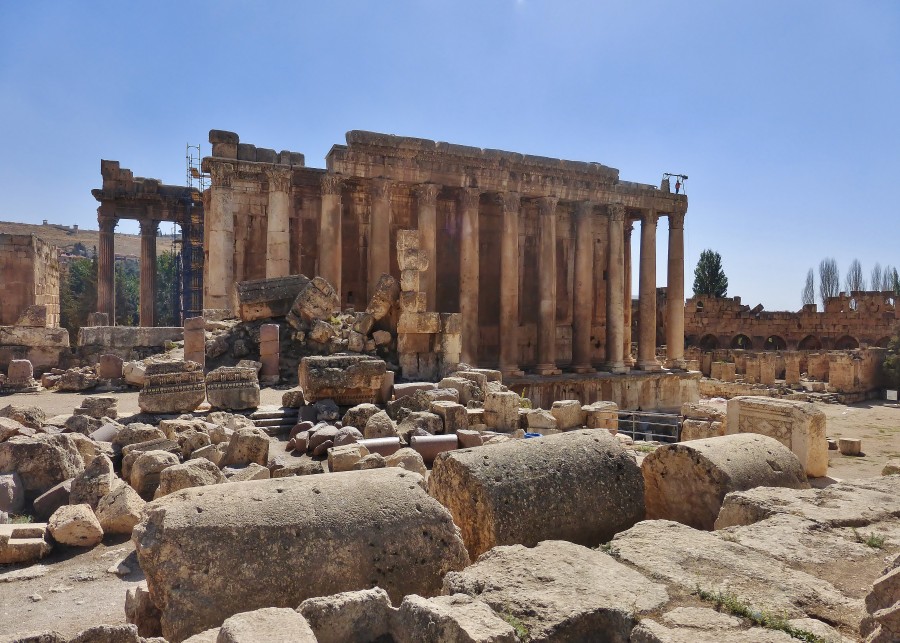
Lebanon; the Roman ruins in Baalbek. The additional attraction of this town is the care of Hezbollah.
On the other side of the main street, about 1km from Heliapolis, there is another, very original attraction of Baalbeck. On the Sheikh Abdullah hill is the largest hewn stone in the world , weighing 1000 tons and 21.2 x 4.8 x 4.2 m. It has been calculated that the stone is so large and heavy that 40,000 men would be needed to move it. This stone was hewn out thousands of years ago, like the material for building the Jupiter Temple, but it was never used, and until recently, because in the 90s it lay under a pile of rubbish.For posterity, he was saved by a certain Pan al-Afi, who took on this one-man mission. According to legend, this stone is also called the “stone of pregnant women” because women who touch it will probably be more fertile.
Before I left Baalbeck, I had a happy situation. Well, I went to a pub with kebabs, forgetting that the whole town is controlled by Hezbollah. When I entered, I saw the Arabs with machine guns at once and realized that everyone was staring at me in great silence, in a suspicious manner. At some point I interrupted their surprise and said the only thing that came to my head, or “kebab?”. Then fat Arabka looked at the armed Hezbollah and they nodded their heads and soon I got a kebab in hand and a bottle of Coke. He was mucked, there were vending machines and many Arabs. I ate, paid, thanked me, went out on the road, stopped my first hitchhiking and did not see me anymore. Goodbye Baalbek.
Transport from Baalbeck to Anjar
Baalbek – Chtaura, 45 minutes, 3,000 lire.
Chtaura – Anjar, 20 minutes, 1,000 llir.
Anjar
Anjar is a small town less than 10km from Syria, which is almost entirely inhabited by Armenians. On the tourist map of the world, Anjar is due to the ruins of the old Umayad city, built at the beginning of the 8th century, near the Litani River, about 58 km from Beirut. Anjar was founded by a ruler with the long and difficult name of Calif Walid ibn ‘Abd al-Malak in 705-715, and its name comes from the phrase “ayn al-jaar”, which means “water from the rock”. It is a reference to the streams flowing from the nearby mountains. Today, the ruins of Anjar are a reminder of the Umayad civilization, and their ancient city, in its heyday, was a commercial center at the crossroads of two routes: from Beirut to Damascus, and from the Bekaa Valley to Tiberiade. Besides, Anjar had a strategic trading location towards the Arabian Peninsula.
Unfortunately, Anjar was never completely expanded as it had strong enemies and therefore its golden time was only 30 years. Where ruins stand today, remains of elegant arches and Roman columns, there used to be 600 shops, a mosque, baths and two palaces. According to archaeologists, the Anjar styles were mixed up because features of Byzantine, early Muslim and Roman architecture were found here. Anjar was a fortified city surrounded by walls and 40 towers covering an area of 385m by 350m. There are ruins of many objects in this area, but in my opinion, the most noteworthy are palaces with impressive arches, and the way the boulders are arranged, taking into account the colors.
Anjar was much smaller than Baalbek and I recommend staying here for about 1.5 hours. That’s enough. You should not expect such magnificent buildings as on the Acropolis, but a visit to Anjar is worth it because it was something new for me.
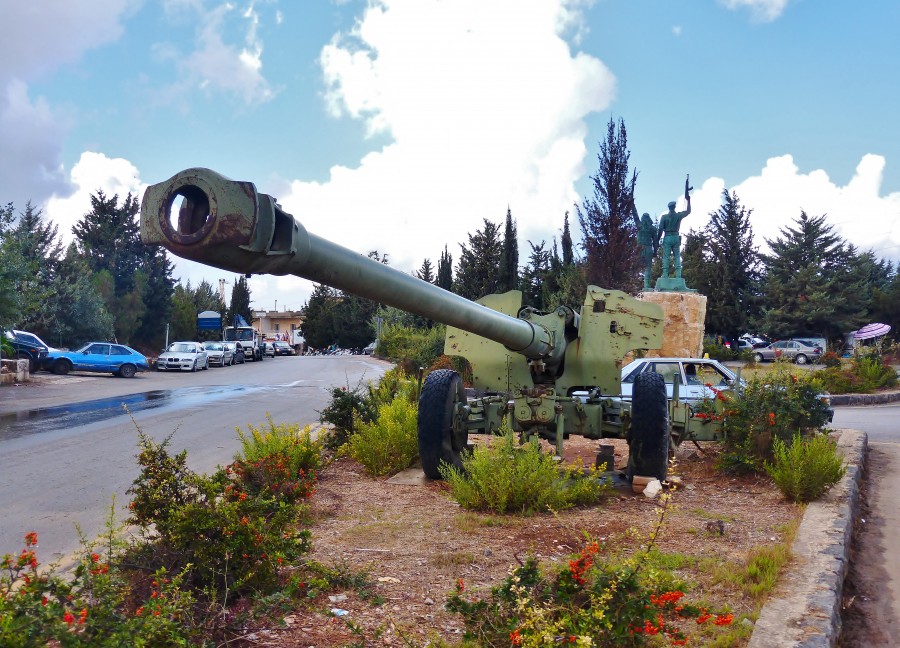
Lebanon; street decoration. With such cannon I could achieve great success in the Democratic Party.
Unfortunately, hotels in Anjar are extremely expensive, so I went to a Shams pub for dinner, and then I wondered what to do next. However, I was served a nasty shalarm with garlic sauce, which made me feel very ill and sick. Previously, I thought that if I could not find a hotel, I would sleep in a tent in the ruins of Anjar, but I felt so bad that I needed peace. Also, the ruins were very interesting, but Anjar was leaving in a bad condition.
The road from Anjar to Zahle
The distances in Lebanon are very small, but still traveling by poor transport and in the heat, takes time and also tiring. So I decided to go to Zahle because it is the center of the Bekaa Valley, where there are better hotels and civilization. First, I hitchhiked from the ruins to the main road, and then I managed to stop another hitchhiking, a 35-year-old Mercedes, which took me to Chtaura. The ride itself was so interesting that I had no guarantee that I would get there, because the Mercedes was barely driving and was smoking a lot. Artouch is a sad little hole that I happily left behind, but there was something good there too, and it was obviously another hitchhiking that drove me to Zahle. Had a room at Troubulsi Hotel for $ 30 even though the asking price was $ 50. Zahle is unfortunately more expensive than Beirut or Tripoli, but at that moment I could pay more because I was in a very weak shape. I was sick all night, but I think that the heat and greasy shawarma finished me.
Zahle
In the morning I still felt bad but luckily the hospital was opposite, where they welcomed me and took care of me. I got a prescription for antibiotics. Zahle is a very nice small town, which perfectly fulfills the function of a base after traveling around the Bekaa Valley, to places like Baalbek, Anjar and to the wine bar around Zahle.
Transport from Zahle to Beirut
Unfortunately, this trip was not pleasant. The driver stopped every now and again because she had too few passengers, and therefore tried to take more money from me. According to him, I was a boggat because “every white is born in golden shoes”. Once he understood that he would not extort one pence more than me, he was so insolent that he wanted my headphones. So I told him to fuck off, and when we finally arrived in Beirut, we parted in average friendship. I think that I will join this driver to “a group of my devoted friends”. Wherever I go, they like me everywhere.
Last day in Beirut and the way to the airport
I returned to Talal, where I rested and took antibiotics. I had two rooms to choose from: one with Syrian doctors for $ 17 and the other with a Negro for $ 14. I could not bear the negro, so I preferred to pay an additional $ 3 and lived with the Syrians, and spent time with them talking about the war in Syria and about the Jews. It was very nice. I also went for my last walk in Beirut to see the Old Town again, the Corniche coast, and concrete blocks and barbed wire. I spent the evening in a bar, where sweaty, angry Arabs baked a pizza.
The next morning I went by bus to the airport for only 1000 lire. The emigration control was problem-free. I was still sick but I managed to fly and soon I flew to Amman.
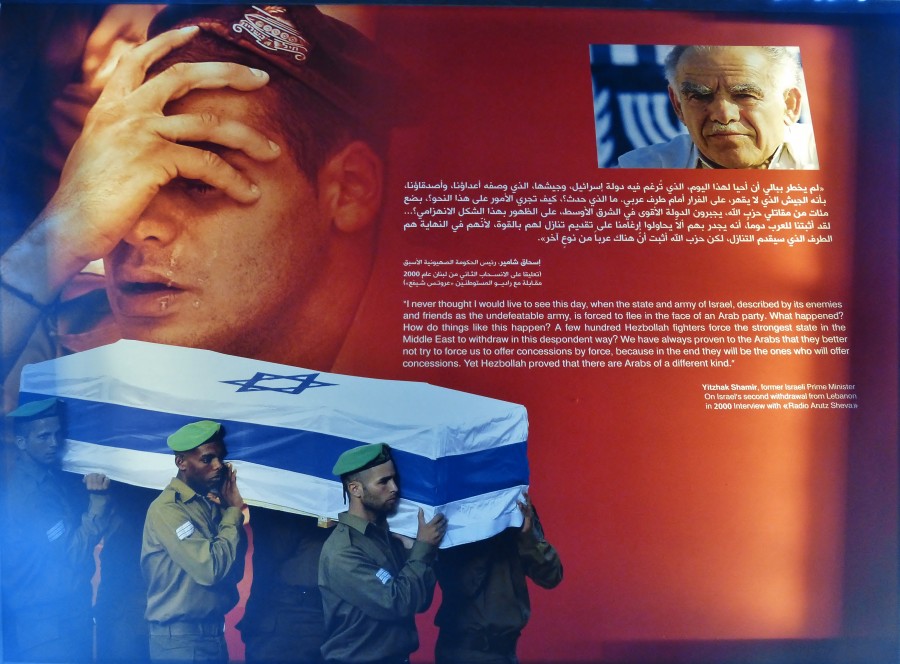
The heroic Hezbollah forces the Zionist terrorists to leave Lebanon.
The summary of Lebanon
Lebanon is a very small country, there is a lot to see, and therefore I warn future travelers that 1 week or even 2 is definitely too short. In such a small area is natural beauty, mountains, sea, Roman ruins and the specific, military disposition of Lebanon. Food is good, transport works well, and people are suspicious but they did not pose a threat to me. Lebanon is also the only country in the Arab world without a desert, and the attention to the 40% of the population of Christians is diverse in terms of culture and differs from other countries in the region.



